616.23 Traffic Control for Field Operations: Difference between revisions
m Clarification of guidance for flags and Advance Warning Rail System (AWRS) |
m →616.23.2.5.1.1 Flags and Advance Warning Rail System: Clarification of the textual guidance for flags and Advance Warning Rail System (AWRS) |
||
| Line 458: | Line 458: | ||
=====616.23.2.5.1.1 Flags and Advance Warning Rail System===== | =====616.23.2.5.1.1 Flags and Advance Warning Rail System===== | ||
All signs within the advance warning area shall be enhanced with flags. Flagger Ahead (WO20-7a) and TRUCK CROSSING (WO8-6) shall have flags regardless of the location within the work zone. Additional signs within the work zone may be enhanced with flags at the district’s discretion, although such practice should be infrequent. All flag assemblies mentioned above must be quantified in the plans and paid for as item 616.10.09, Flag Assembly, per each. | |||
The | The Advance Warning Rail System (AWRS) shall consist of three barricade rails used to enhance the target value of certain signs on [[616.11 Work Zone Duration#616.11.1 Long term stationary operations|long-term stationary operations]]. The AWRS is only installed on the first occurrence of the ROAD/BRIDGE WORK AHEAD (WO20-1) signs on the mainline roadway. | ||
The following are, but are not limited to, ways to install the AWRS: | The following are, but are not limited to, ways to install the AWRS: | ||
Revision as of 11:43, 17 June 2009
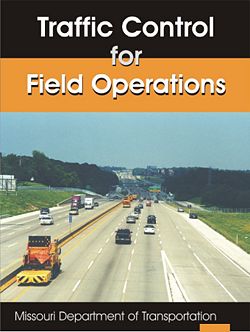
Safety is MoDOT's highest priority. To keep our work zones as safe as possible, MoDOT published the Traffic Control for Field Operations (TCFO) manual in 2002. It establishes minimum expectations for temporary traffic control measures on the state highway system and is valuable when developing a temporary traffic control plan for specific situations. Traffic Control for Field Operations is based upon Part 6 of the the Manual on Uniform Traffic Control Devices (MUTCD) as well as MoDOT policies and best practices. The manual is applicable to incident management, maintenance, permit and utility operations performed on MoDOT right of way. In this article, a maintenance operation shall include any field operation performed by a MoDOT employee.
Guidelines contains basic temporary traffic control guidelines used on the state highway system. These guidelines provide insight into the development of the typical applications and may be used by the supervisor to develop a temporary traffic control plan for a particular situation not covered by one of the typical applications. Typical Applications contains the most common temporary traffic control plans needed for work accomplished within highway right of way. These typical applications feature information on and a schematic of how the temporary traffic control zone is set up.
Supervisors should exercise discretion in the application of these guidelines and typical applications, as deviations may be necessary due to conditions and requirements of a particular site or jurisdiction. Many variables, such as work location, work duration, work type, time of day, weather conditions, road type, geometrics, vertical and horizontal alignment, intersections, interchanges, traffic volumes, traffic mix and traffic speed affect the needs of each zone. Therefore, it may be necessary to modify, enhance or combine typical applications to provide adequate temporary traffic control for a particular situation. If a situation is encountered where none of the typical applications provided can be easily adapted for use, consult the appropriate engineering staff or their designee for assistance to develop a temporary traffic control plan specific to the field condition.
616.23.1 Definitions
 |
Activity Area - Area of a temporary traffic control zone where work activity takes place. It is comprised of the work, traffic and buffer spaces.
Advance Warning Area - Area of a temporary traffic control zone where traffic is informed of the upcoming temporary traffic control zone.
Advance Warning Rail System - Three barricade rails installed to enhance a warning sign and flags.
Area Lighting - Lighting used at night to guide traffic through the temporary traffic control zone.
Annual Average Daily Traffic (AADT) - Volume of vehicular traffic using a section of highway on an average day.
Barricade - Temporary traffic control device consisting of one or three appropriately marked rails used to close, restrict or delineate all or a portion of the right of way.
Barrier-Mounted Sign - Sign mounted on a temporary or permanent traffic barrier.
Buffer Space - Area within the activity area free of equipment, material, and personnel used to provide lateral and/or longitudinal separation of traffic from the workspace or an unsafe condition.
Channelizer - Temporary traffic control device used to guide traffic or delineate an unsafe condition.
Crash Cushion - Temporary traffic control device used at fixed object and other desirable locations to reduce crash severity.
Daytime/Daylight - Period of time from one-half hour after sunrise to one-half hour before sunset.
Detour - Temporary rerouting of traffic onto an existing facility to avoid a temporary traffic control zone.
Diversion - Rerouting of traffic around an activity area using a temporary roadway or portions of an existing parallel roadway.
Divided Highway - Highway with physical separation of traffic in opposite directions.
Downstream Taper - Visual cue to traffic that access back into a closed lane is available.
Emergency Operation - Work involving the initial response to and repair/removal of Response Priority 1 items.
Fine Sign - Regulatory sign indicating the applicability of additional fines in a temporary traffic control zone.
Flag System – A flag bracket and two flag assemblies. Flags are used to enhance signs.
Flagger - Person who provides temporary traffic control by assigning right of way.
Flashing Arrow Panel - Temporary traffic control device with a pattern of elements capable of flashing displays (i.e. left/right arrow, double arrow, caution mode) used to provide warning or guidance to traffic.
Fleet Lighting - Rotating or flashing lights used to increase the visibility of work-related vehicles and equipment in the temporary traffic control zone.
Guide Sign - Sign showing route designations, destinations, directions, distances, services, points of interest or other geographical, recreational or cultural information.
High Speed - Posted speed of 50 mph and above.
Highway - Any facility constructed for the purposes of moving traffic.
Incident Area - Temporary traffic control zone where temporary traffic control devices are deployed in response to a traffic incident, natural disaster, special event, etc.
Intermediate-Term Stationary Operation - Daytime work occupying a location from more than one daylight period up to 3 days or nighttime work occupying a location more than 30 minutes.
Lane Taper - Temporary traffic control measure used to merge or shift traffic either left or right out of a closed lane.
Lateral Buffer Space - Obstacle-free area adjacent to the workspace or an unsafe condition that provides room for recovery of an errant vehicle.
Lighting Device - Temporary traffic control device illuminating a portion of the roadway or supplementing other traffic control devices.
Long-Term Stationary Operation - Work occupying a location longer than 3 days.
Longitudinal Buffer Space - Obstacle-free area in advance of the work space or an unsafe condition that provides room for recovery of an errant vehicle.
Low Speed - Posted speed of 45 mph and below.
Low Volume - 500 or less AADT. The rule of thumb is to count the number of vehicles passing a single reference point over a five-minute period. If not more than three vehicles pass the reference point in that period, then the road can be considered low volume for the purpose of installing work zone traffic control.
Mobile Operation - Work on the roadway that moves intermittently or continuously.
Motorized Traffic - Movement of vehicles and equipment on the roadway.
Multilane Highway - Highway with two or more driving lanes in the same direction of travel.
Nighttime - Period of time from one-half hour before sunset to one-half hour after sunrise.
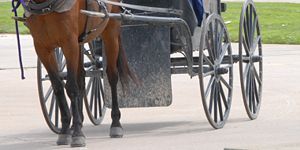
Non-Motorized Traffic - Movement of pedestrians, bicycles, horse-drawn vehicles, etc. on roadway or within the right of way.
One-Lane, Two-Way Taper - Temporary traffic control measure used to channelize traffic through an activity area occupying one lane of an undivided, two-lane roadway.
Pavement Marking - Lines, markers, words and symbols affixed to the pavement surface to channelize and guide traffic.
Pilot Car - Vehicle used to guide a queue of vehicles through the temporary traffic control zone.
Portable Changeable Message Signs (CMS) - Temporary traffic control device capable of displaying a variety of messages to traffic.
Portable Sign - Sign mounted on temporary supports (e.g. self-driving post, easels, foldup stands, barricades, etc.).
Post-Mounted Sign - Sign mounted on a non-portable post (e.g. perforated square steel tube, u-channel, wood, etc.).
Protective Vehicle - Vehicle used to protect workers or work equipment from errant vehicles (e.g. pick up, dump truck, loader, etc.).
Regulatory Sign - Sign giving notice of traffic laws or regulations.
Roadway - Portion of highway, including shoulders, intended for use by motorized traffic.
Rural - Area generally characterized by lower volumes, higher speeds and fewer turning conflicts and conflicts with pedestrians. Includes unincorporated areas designated by community boards.
Safety Apparel - Personal protective equipment worn by a worker to improve visibility (e.g. vests, hats, etc.).
Short Duration Operation - Daytime or nighttime work occupying a location up to 30 minutes.
Short-Term Stationary Operation - Daytime work occupying a location more than 30 minutes, but less than 12 hours.
Shoulder Taper - Temporary traffic control measure used to close the shoulder.
Sign - Traffic control device conveying a static message to traffic through words or symbols.
Speed Limit - Maximum speed applicable to a section of highway as established by law.
Stop Bar - Solid white pavement marking extending across an approach lane to indicate the point where traffic is to stop.
Supplemental Warning Methods - Temporary traffic control enhancements used to increase the effectiveness of select temporary traffic control devices or the awareness of the entire temporary traffic control zone.
Taper - Series of channelizers and/or pavement markings used to move traffic into the intended path.
Temporary Traffic Barrier - Temporary traffic control device used to create a physical separation between traffic and the workspace, an unsafe condition, or non-motorized traffic.
Temporary Traffic Control Device - Item used to regulate, warn or guide traffic through a temporary traffic control zone.
Temporary Traffic Control Plan - Describes temporary traffic control measures to be used for moving traffic through a temporary traffic control zone.
Temporary Traffic Control Signal - Temporary traffic control device used to assign right of way through automatic means.
Temporary Traffic Control Zone - Section of highway where traffic conditions are changed due to a work zone or an incident area through the use of temporary traffic control devices, law enforcement or other authorized officials. It extends from the first warning sign or rotating/strobe lights on a vehicle to the last temporary traffic control device.
Termination Area - Area of a temporary traffic control zone returning traffic to the normal path.
Traffic - Highway user.
Traffic Space - Area within the activity area in which traffic is routed through the activity area.
Transition Area - Area of a temporary traffic control zone where traffic is redirected out of the normal path and into the traffic space.
Traveled Way - Portion of roadway intended for the movement of motorized traffic.
Truck-Mounted Attenuator (TMA) - Device designed to attach to the rear of protective vehicles to absorb the impact of an errant vehicle or inattentive driver.
Undivided Highway - Highway with no physical separation of traffic in opposite directions.
Urban - Area within the limits of incorporated towns and cities where the posted speed is 60 mph or less.
Vehicle-Mounted Sign - Sign mounted on a protective vehicle used in short duration and mobile operations or on a pilot car.
Warning Light - Flashing or steady-burn, amber light units attached to temporary traffic control devices to increase their target value.
Warning Sign - Sign giving notice of a situation or condition that might not be readily apparent.
Work Duration - Length of time an operation occupies a location.
Work Lighting - Lighting used at night to perform activities within the workspace.
Work Location - Portion of right of way in which work is performed.
Workspace - Area within the activity area closed to traffic and set aside for workers, equipment, materials and a protective vehicle, if one is used upstream. Channelizers usually delineate workspaces.
Work Vehicle - Any vehicle by which work is performed.
Work Zone - Temporary traffic control zone where temporary traffic control devices are deployed for construction, maintenance or utility- related work activities.
Work Zone Length - Distance from last sign in the advance warning area to the last temporary traffic control device in the same direction or the last sign in the advance warning area in the opposing direction, whichever is longest.
Refer to 902.12 Glossary for definitions of interchange, intersection and right of way.
616.23.2 Guidelines
 |
The two purposes for establishing a temporary traffic control zone while working within the highway right of way are: 1) to provide for the safe and efficient movement of both motorized and non- motorized traffic through or around the workspace and 2) to provide protection for workers and equipment located within the workspace.
Work in or adjacent to the highway does violate traffic expectations and is performed in vulnerable conditions. However, a properly designed and executed temporary traffic control plan will enable the temporary traffic control zone to provide the above noted functions in the most effective manner possible.
616.23.2.1 Fundamental Principles
Motorized and non- motorized traffic and worker safety is an integral and high-priority element of every incident management, maintenance, permit, and utility operation. Consideration of the following principles should enhance the safety performance of the temporary traffic control zone.
- Prepare a temporary traffic control plan and communicate it to all responsible parties prior to occupying the site.
- Provide those whose actions affect the temporary traffic control zone with training appropriate to their level of responsibility.
- Employ the same basic safety principles used to design permanent roadways.
- Avoid frequent or abrupt geometric changes.
- Minimize delay and disruption.
- Schedule and coordinate operations according to MoDOT Work Zone Guidelines.
- Provide adequate warning, delineation and channelization in advance of and through the affected area.
- Provide positive guidance.
- Provide for safe operation of work.
- Encourage use of alternative routes.
- Assume drivers will only reduce their speeds if they clearly perceive a need to do so.
- Provide for reasonably safe passage of bicyclists and pedestrians.
- Provide recovery areas where practical.
- Coordinate operations with those having jurisdiction over any affected cross-streets, railroads or transit facilities.
- Ensure continuation of emergency services.
- Communicate with and provide reasonable accommodations for adjoining property owners.
- Ensure temporary traffic control devices used are effective, in good working order and reasonably consistent with the traffic control plan.
- Monitor performance of the temporary traffic control and modify as needed.
- Inspect and maintain temporary traffic control devices.
- Remove, cover or turn; and turn off all unnecessary temporary traffic control devices.
- Maintain a record of any crashes or incidents.
- Store unused equipment and material in such a manner to reduce the probability of being hit.
- Involve the media to assist in information dissemination.
616.23.2.2 Temporary Traffic Control Elements
616.23.2.2.1 Traffic Control Plan
A traffic control plan describes temporary traffic control measures to be used for facilitating the movement of traffic through a temporary traffic control zone. They play a vital role in providing continuity of safe and efficient traffic flow when a work zone or an incident area temporarily disrupts normal traffic flow.
Several temporary traffic control plans, referred to as typical applications, are included in this article. These plans are also referenced in 616.1 Preparation of Traffic Control Plan (TCP) and depict the most common applications of temporary traffic control devices used in highway-related operations.
616.23.2.2.2 Temporary Traffic Control Zone
A temporary traffic control zone is a section of highway where traffic conditions are changed due to a work zone or an incident area through the use of temporary traffic control devices, law enforcement, or other authorized officials. It extends from the first warning sign or rotating/strobe lights on a vehicle to the last temporary traffic control device. The zone may either be stationary or move as work progresses.
A temporary traffic control zone consists of four basic components: advance warning, transition, activity and termination.
These areas are illustrated in the following figure.
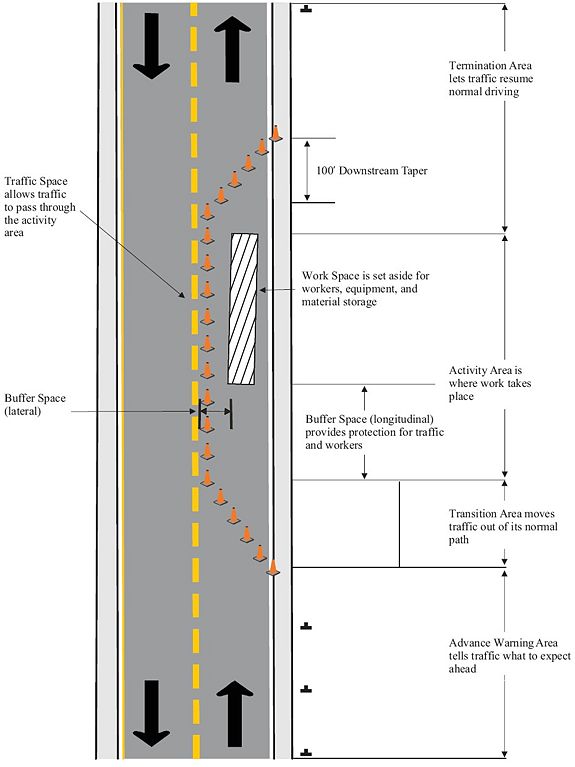
The advance warning area is where traffic is informed of an upcoming temporary traffic control zone. It may vary from a single sign or rotating/strobe lights on a vehicle to a series of signs depending on the duration, location, and type of work.
Recommended sign spacing in this area is shown in the following table.
Table 616.23.2.2.2 Sign Spacing
| Speed Limit, mph | Sign Spacing1, ft. | ||
|---|---|---|---|
| Undivided Highway | Divided Highway | ||
| 0 - 35 | 200 | 200 | |
| 40 - 45 | 350 | 500 | |
| 50 - 55 | 500 | 1000 | |
| 60 - 70 | 1000 | 1000 | |
| 1 Sign spacing may be adjusted, normally by increasing it, to accommodate field conditions and visibility. | |||
The transition area is where traffic is redirected out of their normal path and into the traffic space. This is usually accomplished through the use of a series of channelizers placed in a taper across the portion of roadway to be closed.
There are three types of tapers: shoulder, lane and one-lane, two-way.
- The shoulder taper is used to close the shoulder where it is part of the activity area or when improved shoulders might be mistaken for a driving lane.
- The lane taper is used to close a driving lane by forcing traffic to merge.
Recommended taper length and channelizer spacing for shoulder and lane tapers in the transition area are shown in the following table.
Taper Spacing Chart
| Speed Limit, mph | Taper Length1, ft. | Channelizer Spacing4, ft. | |
|---|---|---|---|
| Shoulder2 (T1) | Lane3 (T2) | ||
| up to 35 | 70 | 245 | 355 |
| 40 to 45 | 150 | 540 | 405 |
| 50 to 55 | 185 | 660 | 506 |
| 60 to 70 | 235 | 840 | 606 |
| 1 Taper lengths may be adjusted to accommodate crossroads, curves, intersections, ramps or other geometric features. | |||
| 2 Based on 10 ft. shoulder width. | |||
| 3 Based on 12 ft. lane width | |||
| 4 Channelizer spacing may be reduced to discourage traffic encroachment. | |||
| 5 Spacing reduced to 1/2 at intersections. | |||
| 6 Spacing may be reduced to 1/2 at intersections. | |||
The one-lane, two-way taper is used to close one lane of a two-lane, undivided highway where the remaining lane is used alternately by traffic in each direction. The taper should have a length of 100 ft. (5 channelizers at 20 ft. spacing).
Should the highway have an improved shoulder, the taper should be extended to the edge of the roadway at the same spacing. In addition to the channelizers, a flagger, STOP or YIELD sign, pilot car or temporary traffic signal controls traffic through this section.
The activity area is where work activity takes place. It is comprised of three spaces - work, traffic and buffer.
The workspace is the area closed to traffic and set aside for workers, equipment, materials and a protective vehicle, if one is used upstream. Workspaces are usually delineated by channelizers or temporary barriers to exclude vehicles and pedestrians.
The traffic space is the area where traffic is routed through the activity area.
The buffer space is the area separating traffic from the workspace or an unsafe area. Since this area provides some recovery space for an errant vehicle, it should be kept free of any work activity, equipment, vehicles and material storage. There are two types of buffer spaces - longitudinal and lateral.
- A longitudinal buffer space may be used in advance of the workspace or to separate opposing traffic flows using portions of the same traffic lane. When an item such as a protective vehicle is located in this space, only the area upstream of the item functions as the buffer space.
- A lateral buffer space may be used adjacent to the workspace, an unsafe condition, or between two lanes, especially those carrying traffic in opposite directions. The minimum width of this space is not set but should be determined based on the type of facility, work activity, condition for which the space is being provided and space available.
Recommended longitudinal buffer length and channelizer spacing in the activity area are shown in the following table.
Recommended Length of Longitudinal Buffer Spaces
| POSTED SPEED PRIOR TO CONSTRUCTION, mph | LENGTH, ft. |
|---|---|
| up to 35 | 120 |
| 40 to 45 | 220 |
| 50 to 55 | 335 |
| 60 to 70 | 550 |
The termination area is where traffic is returned to their normal path. This area extends from the downstream end of the activity area to the last temporary traffic control device. This area may include a downstream taper or a sign informing traffic they may return to normal operations (e.g. END ROAD WORK or Speed Limit). When a downstream taper is used, the recommended length is 100 ft. (5 channelizers at 20 ft. spacing) per lane.
616.23.2.3 Pedestrian and Worker Safety
Pedestrian Considerations
While the majority of temporary traffic control situations involve providing safe and efficient movement of motorized traffic, there are times when this function must also be extended to include pedestrians. In these instances, consideration of the following provisions, in addition to those previously noted in Fundamental Principles, should enhance the safe and efficient movement of pedestrians within the temporary traffic control zone.
- Separate pedestrian movements from the activity area and motorized traffic. In some cases it may be necessary to use a physical barrier instead of channelizers to provide this separation.
- Provide a clearly delineated and usable travel path that nearly replicates the existing path.
- Provide advance notification of sidewalk closures to discourage unsafe pedestrian movements.
- Avoid accessing activity area across pedestrian paths.
Worker Considerations
Of equal importance to the safety of the motorized and non- motorized traffic navigating the temporary traffic control zone is the safety of the worker involved in activities within the zone. Therefore, it is important to comply with the following minimum requirements.
- Train field employees involved in the planning, set- up, operation, maintenance or removal of temporary traffic control to the level of their responsibility. For MoDOT employees, this typically requires the completion of both the Flagger Training and Work Zone Technician courses.
- Require workers to wear the appropriate safety apparel while in the temporary traffic control zone. For MoDOT employees, refer to Safety Policies, Rules & Regulations Employee Handbook.
- Inspect and operate vehicles and equipment within the temporary traffic control zone appropriately. For MoDOT employees, refer to Safety Policies, Rules & Regulations Employee Handbook.
In addition to the above items and those previously noted in Fundamental Principles, consideration of the following should enhance the safety and effectiveness of the workforce.
- Use physical barriers instead of channelizers to separate traffic from the activity
area.
- Reduce speeds through the temporary traffic control zone.
- Use protective vehicles and truck mounted attenuators within the temporary traffic control zone to provide protection from errant vehicles.
- Close the road to traffic temporarily where traffic volumes are low and an adequate alternate route exists.
- Request assistance of law enforcement officials in patrolling the temporary traffic control zone.
- Provide adequate lighting to perform work activities within and guide traffic through the temporary traffic control zone.
- Heighten awareness of the temporary traffic control zone through the use of supplemental warning methods.
- Ensure workers are visible to equipment operators.
- Ensure signal person and equipment operator understand hand signals.
616.23.2.4 Flagger Control
The role of the flagger in temporary traffic control is an important one. It is the flagger’s responsibility to assess the safety and efficiency of traffic operations within the temporary traffic control zone and manage the movement of traffic through the proper assignment of right of way and/or by controlling speed. Guidelines for performing this vital function are set forth in the Flagger Training course materials. It is good practice for flaggers to review these guidelines on a regular basis in order for them to perform their duties effectively.
Except when performed under emergency conditions, workers engaged in flagging operations on the state highway system shall have successfully completed a recognized flagger training course. For MoDOT employees, this requires the successful completion of the Flagger Training course or an approved substitute.
616.23.2.5 Temporary Traffic Control Devices
Temporary traffic control devices are the medium through which traffic is informed of and guided through a temporary traffic control zone or otherwise protected from an unsafe condition. The most common devices include signs, portable changeable message signs, flashing arrow panels, channelizers, barricades, temporary traffic barriers, pavement markings, lighting devices, temporary traffic signals, crash cushions, protective vehicles and truck mounted attenuators.
Due to the placement of these devices in relation to traffic, these devices shall be crashworthy. This requires that all temporary traffic control devices conform to the crash test requirements of the National Cooperative Highway Research Program (NCHRP) Report 350. Exceptions to this crashworthiness rule are those state-owned devices that have received grandfather status (e.g. pre-10/98 TMAs and pre-10/00 sign stands and barricades).
It may become necessary to ballast some of these devices to inhibit their movement due to natural and vehicle-induced wind in the field. This is particularly the case for portable sign supports and channelizers. Ballast shall be selected and installed such that the ballast itself does not become a hazard if impacted by a vehicle. When in doubt on ballasting, consult the device’s manufacturer for their recommendation.
In order for these devices to perform the functions noted previously, they must command the public’s respect. This means the correct devices are installed according to the traffic control plan and they function as intended. Furthermore, the devices are maintained throughout the life of the operation and removed when no longer needed. Devices that are damaged or have lost their functionality should be replaced or, when acceptable, repaired. Refer to ATSSA’s Quality Standards for Work Zone Traffic Control Devices for guidelines regarding acceptability of devices.
616.23.2.5.1 Signs
Temporary traffic control signs convey, in words and symbols, both general and specific messages used by motorized and non-motorized traffic to navigate the temporary traffic control zone safely and efficiently. Therefore, it is important all permanent and temporary signs not applicable to conditions present in the temporary traffic control zone be removed, covered, or turned away from the roadway so they are not visible to traffic.
616.23.2.5.1.1 Flags and Advance Warning Rail System
All signs within the advance warning area shall be enhanced with flags. Flagger Ahead (WO20-7a) and TRUCK CROSSING (WO8-6) shall have flags regardless of the location within the work zone. Additional signs within the work zone may be enhanced with flags at the district’s discretion, although such practice should be infrequent. All flag assemblies mentioned above must be quantified in the plans and paid for as item 616.10.09, Flag Assembly, per each.
The Advance Warning Rail System (AWRS) shall consist of three barricade rails used to enhance the target value of certain signs on long-term stationary operations. The AWRS is only installed on the first occurrence of the ROAD/BRIDGE WORK AHEAD (WO20-1) signs on the mainline roadway.
The following are, but are not limited to, ways to install the AWRS:
- 1. The three barricade rails may be attached to U-channel, wood or PSST posts, according to the minimum sign area (sign and rails) as located in Table B of Standard Plan 616.10.
- 2. A crashworthy skid-mounted sign and rail assembly.
- 3. The sign and three-rail system may be mounted as separate crashworthy devices. The rail system shall be located directly in front of the sign with 7 ft. to 10 ft. separating the two devices.
616.23.2.5.1.2 Sign Classification
Temporary signs are classified into one of three types: regulatory, warning or guide.
Regulatory signs give notice of traffic laws or regulations and indicate applicability of legal requirements that would not be readily apparent. These signs are generally rectangular in shape and have a black legend on white background. Noteworthy exceptions to this rule are the STOP, YIELD, DO NOT ENTER and WRONG WAY signs.
Warning signs give notice to situations or conditions that might not be readily apparent. These signs are generally diamond-shaped and, when used in a temporary traffic control zone, have a black legend or symbol on orange background.
Guide signs indicate route designations, destinations, directions, distances, services, points of interest or other geographical, recreational or cultural information. These signs come in different shapes and colors depending on type and purpose of the signing. However, special guide signs relating to the conditions of the temporary traffic control zone (e.g. RAMP OPEN, DETOUR, ROAD WORK NEXT XX MILES, etc.) are typically rectangular in shape and have a black legend on orange background.
616.23.2.5.1.3 Sign Design
Details, descriptions, and ordering information for signs used for temporary traffic control are specified in 616.2 Work Zone Signing and Applications, as noted in the preceding section.
These signs may have a rigid or flexible substrate. However, the two sign materials are not necessarily interchangeable. Each should be used on a sign support for which the sign system (i.e. the sign and support) has been designed. This is especially true when trying to meet crashworthiness requirements.
Flashing warning lights and/or flags may be used to supplement these signs provided they do not block the sign face.
616.23.2.5.1.4 Sign Installation
Signs used for temporary traffic control are placed on the right side of an undivided highway and on both sides of divided highways unless otherwise specified in this article. Where space exists, signs may also be placed on the left side of multi-lane, undivided highways. Signs should not be located where they will conflict with the movement of non-motorized traffic or where visibility of them will be limited by field conditions.
Recommended sign spacing is shown in Table 616.23.2.2.2, Sign Spacing.
Signs may be supported in one of four methods: on a portable support, break-away post, vehicle or traffic barrier.
Portable signs are temporary traffic control signs affixed to a portable support such as a self-driving post, easel, fold- up sign stand, barricade, etc..
These signs are be constructed of either a rigid or flexible substrate, as required, to meet crashworthiness requirements.
A minimum mounting height of one ft., measured vertically from the bottom of the sign to the near edge of the pavement, is recommended. However, higher mounting heights should be considered on higher volume highways, on multi-lane highways, in urban settings, and where the sign is located in line with other traffic control devices to increase visibility of the sign. Mounting heights for regulatory and guide signs are as specified for post-mounted signs.
Portable signs may be located adjacent to or within the roadway itself. However, a minimum lateral clearance of three ft., measured horizontally from the edge of the sign to edge of the designated traveled way, is recommended.
Signs mounted in this manner may be left in place for up to three days. An exception to this duration is any crosswalk/sidewalk closure, any road closure, Horizontal Arrow, Double-Headed Horizontal Arrow, Chevron, DETOUR (within arrow) or Gore Exit sign. These sign may be left in place for over three days.
When not in use, consideration should be given to removing portable signs from the temporary traffic control zone to discourage theft and limit potential hazards within the right of way.
Post-mounted signs are temporary traffic control signs affixed to a breakaway support such as perforated square steel tube, u-channel, wood, etc..
These signs are constructed of a rigid substrate.
A minimum mounting height of seven ft., measured vertically from the bottom of the sign to the near edge of the pavement, is recommended for urban highways and rural divided highways. A minimum mounting height of five ft., measured vertically from the bottom of the sign to the near edge of the pavement, is recommended for rural undivided highways. If a supplemental sign is mounted below another sign, the mounting height of the supplemental sign may be one ft. less than the heights specified.
A minimum lateral clearance of two ft., measured horizontally from the edge of the sign to the edge of the roadway, is recommended for installations on roadways with curbed sections. A minimum lateral clearance of six ft., measured horizontally from the edge of the sign to the edge of the traveled way, is recommended for installations on roadways without curbed sections.
Vehicle-mounted signs, when allowed in this manual, are temporary traffic control signs affixed to a protective vehicle or pilot car at a recommended minimum height of four ft., measured vertically from the bottom of the sign to the pavement surface.
Barrier-mounted signs are temporary traffic control signs affixed to the top portion of a temporary or permanent traffic barrier. The method of attachment to the barrier must assure a positive connection and minimize potential for vehicle snagging. Mounting heights for regulatory and guide signs are as specified for post-mounted signs.
In order to accommodate narrow medians, it may be necessary to reduce the sign size; clip the sign corners or edges; or possibly both.
616.23.2.5.2 Portable Changeable Message Signs
Portable changeable message signs are temporary traffic control devices with the flexibility to display a variety of messages. These messages provide pertinent traffic operation and guidance information to the motorist. They serve as a supplement to, not as a replacement for or a repeat of, static temporary traffic control signing. In temporary traffic control applications, these units are generally mounted on a trailer.
Some typical situations where portable changeable message sign use may be beneficial to temporary traffic control are as follows.
- Where the speed of traffic is expected to drop substantially.
- Where significant queuing and delay are expected.
- Where adverse environmental conditions exist.
- Where there are changes in alignment or surface conditions.
- Where there is a ramp, lane, or roadway closure.
- Where a crash or incident has occurred.
- Where traffic patterns change.
Messages should consist of a maximum of two phases. Typically, these phases consist of three lines of eight characters. Techniques such as fading, exploding, dissolving, moving, or scrolling text shall not be used. The entire message cycle should be readable to traffic at least twice while traveling at the posted speed. Messages should be programmed prior to deployment of the unit to the field. Consideration of the following guidelines will assist in designing a message.
- Each phase should convey a single thought.
- If the message can be displayed in one phase, the top line should present the problem, the center should present the location or distance ahead, and the bottom line should present the recommended driver action.
- The message should be as brief as possible.
- When a message is longer than two phases, additional portable changeable message signs should be used.
- When abbreviations are used, they should be easily understood.
Signs should be located to provide traffic with ample warning of any conditions ahead or actions they may need to perform.
It is preferable to locate signs off to the right of any usable portion of the roadway. Where field conditions do not allow for this placement, the signs may be located on the outside shoulder of the roadway or within the median where field conditions do not allow for deployment on the outside shoulder. A minimum lateral clearance of three ft., measured horizontally from the edge of the sign to edge of the traveled way, is recommended.
If multiple signs are used, the signs should be located on the same side of the road and separated according to the sign spacing chart.
A minimum mounting height of seven ft., measured vertically from the bottom of the sign to the roadway, is recommended.
When deployed, the sign shall be sighted and aligned with approaching traffic to ensure visibility of the message.
Five channelizers should be used to delineate each sign. These channelizers should be positioned on the upstream end of the unit to form a taper leading up to traffic side of the unit. The recommended length of this taper is 100 ft. For a sign located in the median, the sign should be delineated from both directions.
616.23.2.5.3 Flashing Arrow Panels
Flashing arrow panels are temporary traffic control devices with a matrix of elements capable of flashing displays. The devices are intended to provide additional warning and directional information to assist in traffic movement through or around a temporary traffic control zone. These units may be either trailer- or truck-mounted. However, truck- mounted units are preferred in mobile operations.
The overall minimum dimensions of the panels are 60 in. wide x 30 in. high for truck-mounted units and 96 in. wide x 48 in. high for trailer-mounted units. Panels for both units shall include 15 yellow elements.
Panels may be operated in one of three operating modes: arrow, double arrow and caution. The arrow and double arrow modes are used for stationary or moving lane closures on multilane highways. The arrow mode is used when traffic has no choice but to go left or right while the double arrow mode is used when traffic has the choice to go left or right. The caution mode is used for shoulder work, blocking the shoulder, work within a lane where the lane is not closed, and lane closures on two-lane, undivided highways. When used during night operations, these displays shall be dimmed by 50 percent.
For stationary lane closures, the panel should be deployed on the shoulder or within an adjacent closed lane at the beginning of the lane or one-lane, two-way taper. Where adequate space or the temporary traffic control plan does not permit this placement, the unit may be placed within the taper of the closed lane. When closing multiple lanes, a separate unit shall be used to close each lane.
For moving lane closures on two-lane, undivided highways, the panel shall be deployed within the lane to be closed.
For moving lane closures on multi-lane highways, one panel should be deployed on the shoulder and another shall be deployed within the lane to be closed. Where adequate space does not permit deployment of the unit on the shoulder, the unit may be positioned partially in the lane to be closed. When an interior lane is being closed by itself, both units shall be deployed within the lane to be closed. When closing multiple lanes, a separate unit shall be used to close each lane.
A minimum lateral clearance of three feet, measured horizontally from the edge of the panel to the edge of the traveled way, is recommended for trailer-mounted units deployed as specified in the previous paragraphs.
A minimum mounting height of seven ft., measured vertically from the bottom of the panel to the roadway, is recommended for trailer-mounted units. For truck-mounted units, the panel mounting height should be as high as practical.
When deployed, the panel shall be sighted and aligned with approaching traffic to ensure visibility of the display.
Except when panels are located behind a taper or are truck- mounted, five channelizers should be used to delineate each panel. These channelizers should be positioned on the upstream end of the unit to form a taper leading up to traffic side of the unit. The recommended length of this taper is 100 ft.
616.23.2.5.4 Channelizers
The function of channelizers is to warn motorized and non- motorized traffic of conditions created by temporary activities or conditions in or near the roadway and to guide them through or around these conditions. Uses for these devices include the following.
- Provide smooth and gradual traffic flow from one lane to another, onto a bypass or detour, or into a narrower traveled way.
- Separate traffic from the activity area, pavement drop-offs, opposing traffic or non- motorized traffic.
- Separate non- motorized traffic from the activity area or unsafe conditions.
- Delineate spot obstructions
- Supplement other traffic control devices.
There are four types of channelizers used to perform these functions: cones, drums, trim-line channelizers and direction indicator barricades.
Cones are conical-shaped devices that are orange in color and 28 inches in height. For nighttime operations, they are augmented with bands of retroreflective white sheeting to improve their visibility.
Drums are cylindrical-shaped devices that are orange in color, 36 in. tall, a minimum of 18 in. diameter, and augmented with alternating bands of orange and white retroreflective sheeting.
Trim-line channelizers are conical-shaped devices that are orange in color, 42 in. tall, 8 in. diameter at the base and augmented with alternating bands of orange and white retroreflective sheeting.
These devices are particularly effective in areas like ramps and intersections or where there is limited lateral clearance. In these situations, they provide greater warning and delineation functions than cones while maintaining a smaller footprint than drums.
Direction indicator barricades are 36 in. tall devices consisting of a 24 in. wide x 12 in. tall retroreflective orange panel with a horizontal arrow on top and a 24 in. wide x 8 in. tall panel of alternating orange and white retroreflective stripes at a 45˚ angle on bottom.
These devices may be used in lieu of other channelizers for tapers in the transition area. When used, the arrow on the top panel and the stripes on the bottom panel shall point toward and slope downward, respectively, to the side of the unit in which traffic is to pass.
Recommended channelizer spacing is shown in the table, below.
Table 616.23.2.5.4 Taper Lengths and Spacing of Channelizing Devices
| Speed Limit, mph | Channelizer Spacing1, ft. | |
|---|---|---|
| Taper | Buffer/Work Areas | |
| 0 to 35 | 352 | 502 |
| 40 to 45 | 402 | 1002 |
| 50 to 55 | 503 | 1003 |
| 60 to 70 | 603 | 1003 |
| 1 Channelizer lengths may be reduced to discourage traffic encroachment. | ||
| 2 Spacing reduced to ½ at intersections. | ||
| 3 Spacing may be reduced to 1/2 at intersections. | ||
616.23.2.5.5 Barricades
A barricade is a portable device used to close, restrict or delineate all or a portion of the right of way to motorized and non-motorized traffic. Each unit contains a number of rails augmented with stripes of alternating orange and white retroreflective sheeting on the side facing traffic.
Where a barricade extends entirely or partially across a roadway, the stripes should slope downward at a 45˚ angle across the entire barricade array in the direction in which traffic is to pass. Where both right and left movements are provided, the stripes should slope downward at a 45˚ angle away from the center of the barricade array. Where no movements are provided, the stripes should slope downward at a 45˚ angle toward the center of the barricade array.
The Type I (one rail) and Type III (three rail) barricade configurations are used on the state highway system. The Type III barricade is the preferred option to perform the previously noted operations. The Type I barricade is acceptable for use in non-motorized traffic operations on all highways and in emergency road closures on two-lane, undivided highways.
When a roadway is closed, but access is still allowed for local traffic or work vehicles, barricades may be offset to facilitate movement into and out of the closed area.
616.23.2.5.6 Temporary Traffic Barrier
Temporary traffic barrier may be used in lieu of or in addition to channelizers separating motorized traffic from the workspace, an unsafe condition, or non-motorized traffic. It is not used to form tapers.
Due to the amount of resources needed to put barrier in place, this option is generally reserved for long-term stationary operations where the need for the noted functions is critical.
If barrier is desired, consult with appropriate engineering staff for design requirements prior to installation.
When used, barrier should be supplemented with delineation for increased visibility. This delineation shall match the applicable pavement marking color.
Any end of the barrier installation susceptible to being hit by vehicular traffic shall be protected with a crashworthy end treatment. This requires installation of a barrier height transition for speeds less than or equal to 35 mph or an approved crash cushion for speeds greater than or equal to 40 mph. As an option, barrier may be flared at a rate of 8:1 back to the limits of the clear zone, backslope or curb provided the side slope is 1V:6H (6:1) or flatter.
616.23.2.5.7 Pavement Markings
Pavement markings are the primary means of channelizing and providing guidance to traffic. However, when temporary traffic control activities impact the use of a roadway or when operations eliminate permanent pavement markings, existing pavement markings, or lack thereof, can confuse the motorist.
Changes in roadway use caused by long-term operations should be accompanied by pavement marking revisions (i.e., the removal or obliteration of any pavement markings that are not applicable to current roadway use and the installation of temporary pavement markings). For operations of shorter duration, the other temporary traffic control devices (e.g. channelizers, signs, etc.) deployed will be relied on to provide traffic with the needed channelization and guidance cues. Pavement marking revisions for shorter duration operations may be a possibility but should be considered on a case-by-case basis.
Elimination of permanent pavement markings for a distance of 200 linear ft. or more caused by operations such as leveling course, patching, seal coat, spot sealing, crack pouring, milling and scrub sealing shall be accompanied by the installation of temporary centerline and lane line pavement markings and NO CENTER STRIPE signs, as specified in 616.23.2.5.7 Pavement Markings.
There are four means typically used to provide temporary pavement marking: preformed short-term pavement marking tape, Type 1 temporary raised pavement markers, Type 2 temporary raised pavement markers and pavement marking paint.
Preformed short-term pavement marking tape consists of a 4-in. wide retroreflectorized tape with a pressure-sensitive adhesive on the back. The tape, available in white and yellow, may be used to provide a surrogate permanent pavement marking or it may be cut into 4-ft. long sections and applied to the road surface at 40-ft. intervals as a temporary pavement marking. The length and spacing of the latter pavement marking may be reduced to one-half when marking intersections, ramp gores and other transitional areas. This material is typically used to temporarily mark changes in normal roadway use and to provide temporary marking of centerlines and lane lines when permanent pavement markings are eliminated. It is not recommended for locations where the materials will be subjected to heavy traffic, in areas of heavy turning movements, on short radius curves, or on roadways having loose aggregate on the surface, since the material will not adhere well under these conditions.
Type 1 temporary raised pavement markers consist of an L- or T-shaped flexible tab with a retroreflective sheeting on both faces of the vertical section and a pressure-sensitive adhesive on the base. These markers, available in white and yellow, are typically used to temporarily mark centerlines and lane lines by applying them to the road surface at 40-ft. intervals prior to, or after depending on the type of surface treatment, an operation and removing the protective film covering the retroreflective sheeting upon completion of the operation. This spacing may be reduced to one-half when marking intersections, ramp gores and other transitional areas. Type 1 markers are the preferred means of providing temporary marking on rough surfaces.
Type 2 temporary raised pavement markers consist of a plastic dome with reflectors on the sides and a pressure-sensitive adhesive on the base. These markers, available in white and yellow, are typically used to temporarily mark changes in normal roadway use by applying them to the road surface at 40-ft.intervals. This spacing may be reduced to one-half when marking intersections, ramp gores and other transition areas. Type 2 markers work well on concrete and smooth asphaltic surfaces.
Pavement marking paint consists of applying a 4-in. wide strip of acrylic waterborne paint with drop-on glass beads for retroreflectivity. The paint, available in white and yellow, may be used to provide a surrogate permanent pavement marking or it may be applied in 4-ft. long sections at 40-ft. intervals as a temporary pavement marking. The length and spacing of the latter pavement marking may be reduced to one-half when marking intersections, ramp gores and other transition areas. This material is typically used to temporarily mark changes in normal roadway use and to provide temporary marking of centerlines and lane lines when permanent pavement markings are eliminated.
In addition to providing temporary pavement markings, NO CENTER STRIPE signs may also be warranted. NO CENTER STRIPE signs are black-on-orange warning signs used on two-lane and two-lane with auxiliary lane facilities where no-passing zone centerline marking is eliminated for 200 linear ft. or more. These signs are placed in advance of the missing no-passing zone centerline markings area at the recommended sign spacing. For extended areas continuously or intermittently missing no-passing centerline marking, NO CENTER STRIPE signs should also be installed within 150 ft. after the intersection of a state highway and at two-mile spacing throughout the affected area. Upon the discretion of the supervisor, additional NO CENTER STRIPE signs may be installed within 150 ft. after other intersections. When a sign placed at the two-mile interval and one placed after an intersection fall within one-eighth mile of each other, the sign placed at the two-mile interval may be eliminated.
When temporary pavement markings and/or NO CENTER STRIPE signs are necessitated by either a change in roadway use or the elimination of permanent pavement markings, the following provisions shall be incorporated into the operation.
- Those performing the operation shall be responsible for coordinating the procurement, installation, maintenance and removal, as applicable, of pavement markings, temporary or permanent, and any NO CENTER STRIPE signs.
- Temporary pavement markings and any NO CENTER STRIPE signs shall be in place prior to opening a roadway to traffic. However, on two-lane highways with AADTs less than 1000, installation of pavement markings may be delayed up to 5 working days, initiated by the elimination of the permanent pavement markings, provided the required NO CENTER STRIPE signs are in place as prescribed previously prior to opening the facility to traffic.
- Temporary centerline and lane line pavement markings and any NO CENTER STRIPE signs shall be in accordance with Standard Plan 620.10. Note: Temporary marking of edgelines is not required.
- Permanent pavement markings should be installed no later than 15 calendar days after any operation has been completed. However, delays in installation should be minimized where possible.
- Removal or obliteration of all pavement markings shall be complete and leave minimal pavement scarring. Concealing any pavement marking with black paint or asphalt is not acceptable.
616.23.2.5.8 Lighting Devices
There are two purposes for providing lighting devices in temporary traffic control zones. The first purpose is to illuminate a portion of the roadway in order to safely and effectively perform work activities or to highlight areas requiring increased driver attention. This is accomplished through work and area lighting, respectively. The second purpose is to supplement other temporary traffic control devices or to identify work vehicles and equipment. This is accomplished through warning and fleet lighting, respectively.
Work lighting enhances worker safety and quality of the work performed during nighttime operations by illuminating the work area to a level at which workers can adequately see what they are doing. A minimum intensity of five footcandles is recommended to satisfy this objective. Typically, this lighting is provided by an array of vehicle- or equipment-mounted floodlights, an array of floodlights on a portable lighting unit, or an internally illuminated balloon. Lighting shall be positioned so that it does not cause glare for motorists, spill onto adjacent properties, create shadows within the workspace or become a safety concern.
Area lighting illuminates specific areas significant to traffic guidance within the temporary traffic control zone during nighttime hours. Lighting of this nature is required at flagger stations and may be considered at gore areas, transitions, ingress and egress areas, equipment crossings, intersections, and temporary signals. A minimum intensity of 0.6 footcandles in the specific area is recommended for this type of lighting. Typically, this lighting is provided by a single light on a portable lighting unit or mounted on a temporary pole. As with work lighting, lighting shall be positioned such that it does not cause glare for motorists, spill onto adjacent properties, create shadows or become a safety concern.
Warning lights are an option available to increase the target value of other temporary traffic control devices. Typically, a single self-contained unit that emits a yellow light is used for this type of lighting. There are three types of warning lights: A, B and C.
- "Type A warning lights" are low-intensity, flashing light units capable of being visible from a distance of 3000 ft. on a clear night. These units may be used during nighttime hours to warn motorists they are approaching or proceeding through a potentially hazardous area. Their use is limited to supplementing other traffic control devices throughout the temporary traffic control zone. They are not be used for delineation.
- "Type B warning lights" are high-intensity, flashing light units capable of being visible from distance of 1000 ft. on a sunny day with the sun directly on or behind the device. These units may be used during both daytime and nighttime hours to warn motorists they are approaching a potentially hazardous area. Their use is limited to supplementing signs in the advance warning area and other temporary traffic control devices at point locations throughout the temporary traffic control zone. They are not be used for delineation.
- "Type C warning lights" are steady-burn light units capable of being visible from a distance of 3000 ft. on a clear night. These units may be used during nighttime hours to delineate the intended path. Their use is limited to supplementing a traffic control device in a lane taper; one- lane, two-way taper; diversion, curve, and similar conditions. Note: When used to help delineate curves, light units shall only be placed on the outside of the curve.
Warning lights shall be mounted at a minimum of 30 in., measured from the base of the host device to the bottom of the unit, exclusive of any housing. In addition, lights should be installed so they do not hinder the functionality of the device they supplement or become a hazard themselves.
Fleet lighting increases the visibility of work or incident response vehicles and equipment while in the temporary traffic control zone. All work vehicles and equipment shall be equipped with an acceptable warning light system. These lights shall be activated whenever a vehicle or piece of equipment is engaged in a work zone or incident response operation within the temporary traffic control zone. An exception to this requirement is those vehicles and pieces of equipment located within a workspace delineated by channelizers or protected by temporary traffic barrier. For this situation, activation of the lights is not required. Standard hazard warning lights may be used as a supplement to, but not as a replacement for, fleet lighting.
616.23.2.5.9 Temporary Traffic Control Signals
Temporary traffic control signals are used at haul road or equipment crossings, on onelane, two-way operations, and at temporary intersections located within the temporary traffic control zone to assign vehicular right of way. Typically, this is done with temporary span-wire installations or trailer- mounted units.
Consideration of the following factors will assist in the design and application of a signal installation.
- Site characteristics (e.g. safety and traffic needs; traffic volumes and speeds; sight distance and turning restrictions; side streets and driveways; parking; pedestrians; existing traffic control devices; human factors; etc.)
- Temporary traffic control design details (e.g. work staging; operation location and duration; feasibility of using other temporary traffic control measures; placement of this and other temporary traffic control devices; etc.)
- Functional aspects (e.g. signal phasing and timing requirements; full-time or part-time operation; actuated, fixed-time, or manual operation; interconnection with other temporary or permanent signals; etc.)
- Operational issues (e.g. power source; operation, inspection, and maintenance needs; record keeping; etc.)
When used, signals shall be installed and operated in accordance with EPG 902 Signals. In addition, the signals shall meet the physical display and operational requirements of conventional signals.
A traffic engineer or their designee shall approve all timing of the signal. In one-lane, two-way situations, this timing shall include an all-red interval of sufficient duration for traffic to clear the portion of roadway controlled by the signal.
A minimum lateral clearance of 3 ft., measured horizontally from the edge of the trailer to the edge of the traveled way, is recommended for trailer-mounted units.
When deployed, signal heads shall be properly aligned with approaching traffic to ensure visibility of the indications.
Five channelizers should be used to delineate each trailer- mounted signal. These channelizers should be positioned on the upstream end of the unit to form a taper leading up to traffic side of the unit. The recommended length of this taper is 100 ft.
616.23.2.5.10 Crash Cushions
Crash cushions are systems that mitigate the effects of errant vehicles impacting roadside obstacles such as fixed objects or exposed barrier and guardrail ends. The system is designed to accomplish this by either smoothly decelerating the vehicle to a stop or redirecting the vehicle.
Due to variability of site conditions, systems shall be selected on a case-by-case basis. Consult appropriate engineering staff for this assistance.
616.23.2.5.11 Protective Vehicles
Protective vehicles are used to safeguard the workspace from errant vehicles. In some operations, these devices also serve as platforms for signs and other devices used to warn traffic of upcoming conditions or inform them of needed actions. For increased motorist, driver and worker safety, the protective vehicle may be equipped with a truck-mounted attenuator.
Protective vehicles should provide sufficient warning to approaching traffic and maximum protection to workers and equipment. This implies the protective vehicle be positioned so that it is clearly visible to approaching traffic, minimizes any vehicular encroachment into the area between the protective vehicle and the workspace, and maintains a recommended minimum of 150 ft. clear roll ahead distance between the vehicle and the workspace.
The wheels of the protective vehicle should be aligned with traffic at all times. In addition, the emergency brake shall be set and the transmission put into neutral in stationary operations.
616.23.2.5.12 Truck-Mounted Attenuators
Truck-mounted attenuators are energy-absorbing devices attached to the rear of trucks used as protective vehicles. These devices are designed to protect the motorist and protective vehicle driver upon impact.
In general, the guidelines for the use of these devices are shown in Table 612.1 Use of TMAs.
616.23.2.5.13 Supplemental Warning Methods
It may, on occasion, be desirable to enhance the target value of certain temporary traffic control devices or the entire zone. The purpose of this is to increase awareness of the temporary traffic control zone or specific conditions within it.
Typical methods for accomplishing this objective include supplementing the prescribed devices with other devices, adding devices to the zone, or changing the characteristics of a device itself. Examples of possible enhancements are as follows.
- Cones by signs or at flagger stations
- Increased sign height
- Additional signs
- More or increased levels of retroreflectivity
- Warning lights on devices
- Area lighting
- Speed trailers
- Light bars on vehicles
616.23.2.6 Temporary Traffic Control Zone Operations
616.23.2.6.1 Duration of Work
Work duration is a major factor in determining the number and types of devices used in temporary traffic control zones. The duration of a temporary traffic control zone is defined relative to the length of time an operation occupies a location. There are six categories of work duration - long-term stationary, intermediate-term stationary, shortterm stationary, short duration, mobile and emergency.
Long-term stationary operations include planned work occupying a location more than three days. Post-mounted signs, larger channelizers and barricades, temporary traffic barriers, temporary pavement markings, work lighting, area lighting, warning lighting and temporary traffic signals are devices generally in corporated into the temporary traffic control plan for these operations. In addition to providing a greater margin of safety, these types of devices provide superior operational characteristics - an important consideration during nighttime hours and periods when workers are not present.
Intermediate term stationary operations include planned daytime work occupying a location from more than one daylight period up to three days or planned nighttime work occupying a location more than 30 minutes.
In these operations the same procedures and devices used in long-term stationary operations may be desirable. However, their use should be carefully considered, as they may not be feasible or practical to deploy. The increased time to place and remove these devices in some cases could significantly lengthen the project, thus increasing exposure time.
Short-term stationary operations include planned daytime work occupying a location for more than 30 minutes, but less than twelve hours. This category describes the majority of work zone activities undertaken on the state highway system.
In these operations, procedures and devices are usually simplified when compared to intermediate and long-term stationary operations because workers are present to maintain and monitor the temporary traffic control zone, the zone is only set up during daylight hours and it is only in place for a relatively short period of time. Portable signs, flashing arrow panels, channelizers, fleet lighting, protective vehicles and truck-mounted attenuators are devices generally incorporated into the temporary traffic control plan for these operations.
Short duration operations include planned daytime or nighttime work occupying a location up to 30 minutes.
These operations might involve different types of temporary traffic control devices since it often takes longer to set up and remove the temporary traffic control than it does to perform the actual work. Vehicle-mounted signs, truck-mounted flashing arrow panels, fleet lighting, protective vehicles, channelizer cones and truck-mounted attenuators are typical devices considered for use in these types of operations.
Mobile operations include planned work that moves intermittently or continuously. These operations often involve frequent, short stops for activities where workers are on foot. These stops can only last up to 15 minutes in duration. Typical work activities include litter cleanup and pothole patching.
Due to the similarity of these activities to short duration operations, the same procedures and devices considered for use in short duration operations are also desirable for use in these types of mobile operations. When non-mobile devices like portable signs are used, they should be moved periodically to keep them near the operation.
Mobile operations also include work activities in which workers and equipment move along the roadway without stopping. Typical work activities include mowing, snow removal, spraying, sweeping and long-line striping.
In these types of activities the advance warning area moves with the operation. Therefore, total mobility of the temporary traffic control zone is important and devices should be chosen accordingly. In some continuously moving operations, a work vehicle equipped with fleet lighting may be sufficient. In others, a protective vehicle equipped with fleet lighting, a truck-mounted attenuator, a flashing arrow panel and a sign may be needed. Where work proceeds at unusually slow speeds, less than five miles per hour, it may be desirable to place warning signs along the roadway and move them periodically as work progresses.
Emergency operations include unplanned work occupying a location up to 15 minutes. Within MoDOT, these operations consist of the initial response to and repair/removal of safety concerns as defined by Response Priority 1 items (refer to the MoDOT's Incident Response Plan).
In these operations, it is usually more advantageous, from a safety standpoint, to remove or provide warning of the risk in a timely manner with limited temporary traffic control than it is to set up a temporary traffic control zone for short duration operations. The decision to reduce the temporary traffic control shall be at the discretion of the supervisor. However, work activities shall still be performed with the safety of the motorist and worker in mind. A vehicle-mounted sign, truck-mounted flashing arrow panel and fleet lighting are devices generally incorporated into the temporary traffic control plan for these operations. A protective vehicle and truck-mounted attenuator should be considered as additional safety measures.
616.23.2.6.2 Location of Work
In addition to work duration, work location is also a major factor in determining the temporary traffic control needed for a temporary traffic control zone. As a general rule, the closer the work activity is to traffic, the greater the need for and number of temporary traffic control devices. Typically, the degree of temporary traffic control is based on three locations - work beyond shoulder, work on shoulder and work within the traveled way.
Work outside the shoulder includes any work performed between the edge of the shoulder, the edge of the travelway where no shoulder exists, to the right of way line or within any unimproved median.
Work performed in this area typically requires a minimal amount of temporary traffic control, such as signs and fleet lighting, or even none at all. The amount and type of temporary traffic control depends on the lateral displacement of the work activity and the location and movement of any work vehicle or equipment relative to the edge of the shoulder, or travelway where no shoulder exists.
Work on shoulder includes any work performed on the shoulder that does not significantly encroach upon the adjacent driving lane. Where no shoulder exists, this also includes any work performed adjacent to the roadway that encroaches, but not significantly, upon the adjacent driving lane. A significant encroachment means 10 ft. of driving surface cannot be maintained for traffic.
Work within the travelway includes any operation requiring a lane closure. Due to the location of the operation, more temporary traffic control devices are required to ensure the safety of both the motorist and the worker. Mobile operations typically require a vehicle-mounted sign, flashing arrow panel, fleet lighting, protective vehicle and truck-mounted attenuator. Stationary operations usually require the substitution of multiple stationary signs for the single vehicle-mounted sign and the addition of channelizers and flaggers.
616.23.2.7 Miscellaneous Temporary Traffic Control Items
616.23.2.7.1 Work Zone Length
While it is important to grab the motorist's attention as they approach the temporary traffic control zone, it is just as important to maintain their attention as they travel through the zone. To accomplish this, the work zone length, including any areas of inactivity within this length, should be kept to a minimum.
The work zone length is defined as the distance from the last sign in the advance warning area to the last temporary traffic control device in the same direction or to the last sign in the advance warning area in the opposing direction, whichever is longest.
The recommended maximum work zone length is shown in the following table.
Table 616.23.2.7.1 Maximum Work Zone Lengths
| Highway Type | Work Zone Length |
|---|---|
| Urban | 1 mile |
| Rural Divided | 2 miles |
| Rural Undivided | 3 miles |
616.23.2.7.2 Speed Limits
MoDOT has the authority to set speed limits on the state highway system. This power extends to establishing speed limits in temporary traffic control zones, where the speed limit may be reduced from the normal speed limit for safety purposes.
A reduced speed limit should be carefully considered before it is imposed, as motorists will only reduce their speed if they perceive a need to do so. Any decision to reduce the speed limit based on an arbitrary, 'across the board', or other inappropriate rationale may result in non-compliance with the reduced speed limit by motorists and a false sense of security for workers.
Should a reduced speed limit be deemed appropriate, the following table shows the recommended maximum speed reductions or the minimum speed that may be imposed in temporary traffic control zones.
Table 616.23.2.7.2 Maximum Speed Reductions or Minimum Speeds
| Highway Type | Posted Speed Limit | Activity (i.e. Workers, Equipment or Material) Location from Edge of Traveled Way | Work Area Protection | |
|---|---|---|---|---|
| Protected1 | Unprotected2 | |||
| Multilane | > 55mph | > 30 ft. | Posted | |
| ≤ 30 ft. | Posted | Posted-10 | ||
| In Traffic Lane | Posted-10 | Posted-20 | ||
| (Min. 45 mph) | ||||
| Head-to-Head | Posted-10 | |||
| ≤ 55mph | > 10 ft. | Posted | ||
| ≤ 10 ft. | Posted | Posted-10 | ||
| In Traffic Lane | Posted-10 | |||
| Head-to-Head | Posted | |||
| Two-Lane/Two-Way | > 55mph | >30 ft. | Posted | |
| > 10 ft. to 30 ft. | Posted | Posted-10 | ||
| (Min. 55 mph.) | ||||
| ≤ 10 ft. | Posted | Posted-20 | ||
| (Min. 45 mph.) | ||||
| In Traffic Lane | 35 mph3 | |||
| ≤ 55 mph | > 10 ft. | Posted | ||
| ≤ 10 ft. | Posted | Posted-10 | ||
| In Traffic Lane | 35 mph3 | |||
| "Posted" inidicates posted (existing) speed prior to work activity. | ||||
| "Posted - XX" indicates a reduction in the speed limit by the amount shown in mph. | ||||
| "Multilane" or "Two-lane/Two-way" indicates existing geometrics prior to work activity. | ||||
| 1 A "Protected" activity is one physically shielded by a crashworthy device (e.g. temporary traffic barrier, guardrail, etc.). | ||||
| 2 An "Unprotected" activity is one not shielded by crashworthy device (see previous note), but may only be delineated by channelizers or pavement markings. | ||||
| 3 Conditions may allow for speeds greater than 35 mph. | ||||
After selecting a reduced speed limit based upon the table above, the following guidelines will assist in the proper installation and application of that reduced speed limit in the temporary traffic control zone.
- If roadway geometrics (e.g. temporary bypass, narrow lane, etc.) during the work activity require a lower speed limit than the one shown in the table above, the speed shall be based on geometrics. However, no speed limit shall be reduced below 35 mph, except when local ordinance provides for a lower speed. The lower speed shall be used when applicable.
- When the reduced speed applies to the entire temporary traffic control zone, speed limit and SPEED LIMIT XX AHEAD, if applicable, signs shall be inserted in between the first and second advance warning signs at the prescribed sign spacing. If the reduced speed only applies to a specific section within the zone, the signing shall be placed in advance of the condition for which the reduced speed is deemed necessary at the prescribed sign spacing. Note: Speed Limit and SPEED LIMIT XX AHEAD signs are not shown on the typical applications.
- For speed reductions greater than ten mph, additional notification should be provided through the use of the SPEED LIMIT XX AHEAD sign.
- For speed reductions greater than 20 mph, the speed limit should be reduced in two stages.
- On divided highways, the reduced speed is applicable to the affected direction of travel only.
- Existing speed limit signs within the temporary traffic control zone shall be covered or removed.
- Speed limit signs indicating the normal speed limit should be installed at the end of the reduced area provided no other reduction is imposed within the next one-half mile or no existing speed limit sign is located within the next one- half mile.
- Reduced speed limit signing shall be removed, covered, or turned from traffic when conditions requiring the reduced speed no longer exist.
- A special activity within a temporary traffic control zone may require a lower speed limit than the one imposed for the zone itself. The further reduced speed limit shall only be effective for the duration of that special activity and should comply with these guidelines.
616.23.2.7.3 Fine Signs
In an attempt to improve work zone safety, the legislature passed a bill in 2001 and amended it in 2006, to provide for increased fines for speeding or speeding and passing in properly posted temporary traffic control zones when workers are present. The required posting is accomplished though the installation of fine signs.
Fine signs provide the motorist with information on the amount of fine and for what action the fine will be assessed. As with other regulatory signs, these signs are most effective if they are properly applied and enforced.
The implementation of the speeding portion of this provision may be considered when all four of the following criteria are met or where, upon the judgment of the supervisor, there is a need to control speed through the temporary traffic control zone.
- Work duration longer than 4 hours.
- Reduced speed limit in effect.
- Normal posted speed greater than or equal to 60 mph.
- Workers on roadway without barrier protection.
The implementation of the passing portion of this provision may be considered when, in addition to meeting the previous criteria or judgment, there is a lane drop on a multilane highway consisting of a maximum of two lanes in the affected direction.
When fine signs are used, their location, as well as other signing requirements, shall conform to the following illustration.
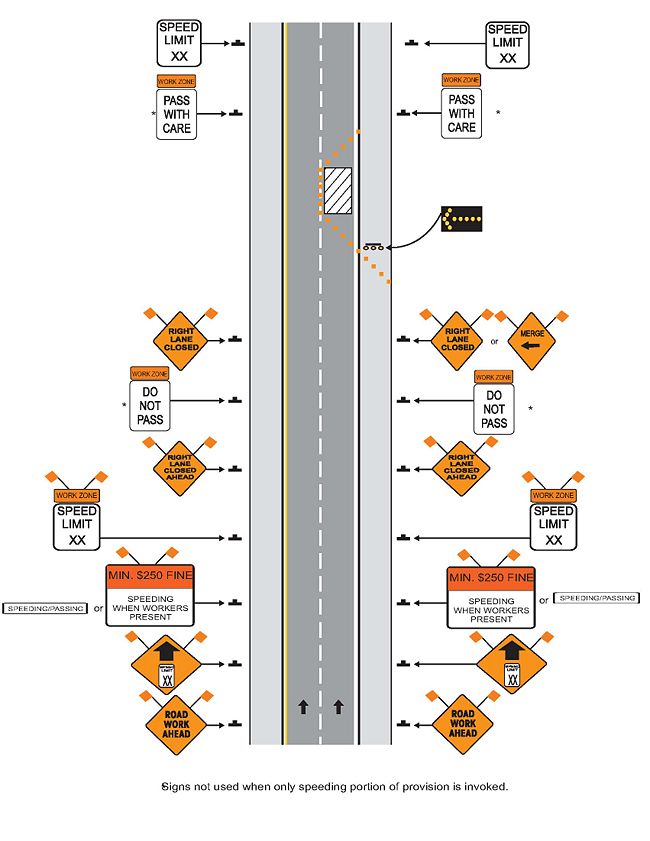
616.23.2.7.4 Railroads
When a highway-rail grade crossing exists within or upstream of the transition area and backups resulting from the lane closure might extend through the highway-rail grade crossing, the temporary traffic control zone should be extended so the transition area precedes the highway-rail grade crossing.
616.23.2.7.5 Excavations
When work activities involve movement of soil or subsurface operations, utilities shall be located by calling DIG-RITE, the local provider and MoDOT.
Unprotected excavations or repairs located within the roadway shall be backfilled or plated while workers are not present. In locations where fills or plates affect the profile of the roadway (e.g., fills appreciably higher or lower than the road surface, thick plates, etc.), the responsible party should install a BUMP or DIP sign, as appropriate, along the edge of the roadway, immediately adjacent to the location. If plated between October 1 and March 31, the responsible party should install a STEEL PLATE IN ROADWAY or BUMP sign along the edge of the roadway, immediately adjacent to the location, and convey the location of the site to appropriate MoDOT personnel.
616.23.2.7.6 Pavement Maintenance Operations
When needed, FRESH OIL, LOOSE GRAVEL or FRESH OIL/LOOSE GRAVEL signs, as applicable, shall be incorporated into the advance warning signs at the prescribed spacing. Signs shall be placed at the start of the project. Signs should also be installed within 150 ft. after the intersection of a state highway. Upon the discretion of the supervisor, additional signs may be installed within 150 ft. after other intersections. Where the FRESH OIL/LOOSE GRAVEL affected area is discontinuous, additional signs should be considered.
616.23.3 Typical Application
 |
| pdf. version of TA-1 |
616.23.3.1 TA-1 Work Beyond the Shoulder on Divided and Undivided Highways
Table 616.23.3.1.1
| Speed | Sign Spacing (ft.) | Taper Length (ft.) | Optional Buffer Length, B (ft.) | Channelizer Spacing (ft.) | |||
|---|---|---|---|---|---|---|---|
| Undivided, S | Divided, S | Shoulder, T1 1 | Lane, T2 2 | Tapers | Buffer/Work Areas | ||
| 0 - 35 | 200 | 200 | - | - | - | - | - |
| 40 - 45 | 350 | 500 | - | - | - | - | - |
| 50 - 55 | 500 | 1000 | - | - | - | - | - |
| 60 - 70 | 1000 | 1000 | - | - | - | - | - |
| 1 Shoulder taper length based on 10 ft. (standard shoulder width) offset | |||||||
| 2 Lane taper length based on 12 ft. (standard lane width) offset | |||||||
| Table 616.23.3.1.2 | ||
| Roadway Type | Sign Height | Max. Work Zone Length, L |
|---|---|---|
| Urban | 1 ft., Portable | 1 mile |
| 7 ft., Post | ||
| Rural Divided | 1 ft., Portable | 2 miles |
| 7 ft., Post | ||
| Rural Undivided | 1 ft., Portable | 3 miles |
| 5 ft., Post | ||
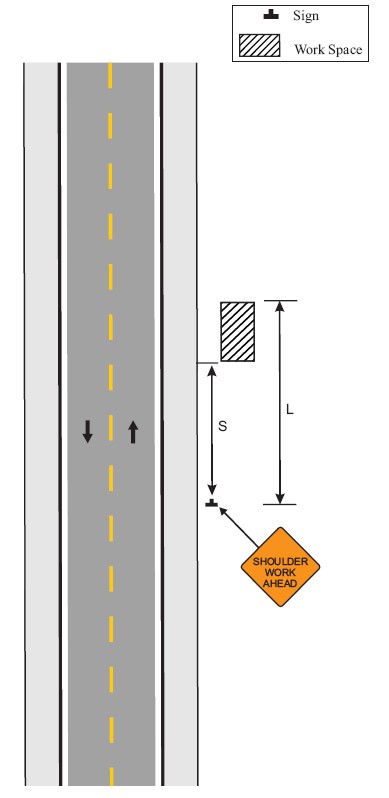
If work vehicles or equipment are located on the shoulder, refer to appropriate shoulder work typical applications.
On multilane, divided highways, signs advising of shoulder work or the condition of the shoulder should be placed only on the side of the affected shoulder.
If work is being performed in the median, signs may be required for both directions of travel based on the following paragraph.
The SHOULDER WORK AHEAD sign may be omitted where the workspace is 15 ft. or more from the edge of any shoulder, beyond the ditch line, or behind the curb. Should the roadway not have a shoulder, then 15 ft. or more from the edge of the roadway.
For short duration or mobile operations, signs may be reduced or eliminated if a work vehicle with activated rotating lights or strobe lights is used.
Other appropriate signs may be used in lieu of the SHOULDER WORK AHEAD sign.
Where sidewalks are impacted, refer to 616.23.3.24 TA-24 Sidewalk Detour or Diversion or 616.23.3.25 TA-25 Crosswalk Closures and Pedestrian Detours.
| pdf. version of TA-2 |
616.23.3.2 TA-2 Shoulder Work on Undivided Highways
Table 616.23.3.2.1
| Speed | Sign Spacing (ft.) | Taper Length (ft.) | Optional Buffer Length, B (ft.) | Channelizer Spacing (ft.) | |||
|---|---|---|---|---|---|---|---|
| Undivided, S | Divided, S | Shoulder, T1 1 | Lane, T2 2 | Tapers | Buffer/Work Areas | ||
| 0 - 35 | 200 | - | 70 | - | 120 | 35 | 50 |
| 40 - 45 | 350 | - | 150 | - | 220 | 40 | 100 |
| 50 - 55 | 500 | - | 185 | - | 335 | 50 | 100 |
| 60 - 70 | 1000 | - | 235 | - | 550 | 60 | 100 |
| 1 Shoulder taper length based on 10 ft. (standard shoulder width) offset | |||||||
| 2 Lane taper length based on 12 ft. (standard lane width) offset | |||||||
| Table 616.23.3.2.2 | ||
| Roadway Type | Sign Height | Max. Work Zone Length, L |
|---|---|---|
| Urban | 1 ft., Portable | 1 mile |
| 7 ft., Post | ||
| Rural Undivided | 1 ft., Portable | 3 miles |
| 5 ft., Post | ||
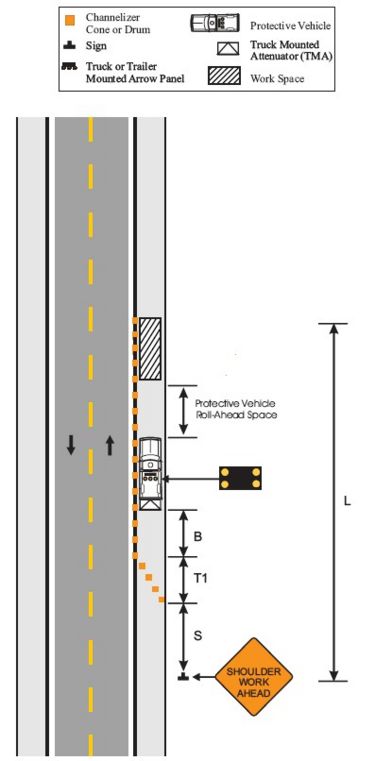
In addition to shoulder work, this typical application is applicable to work beyond shoulder where vehicles and equipment are parked on the shoulder.
A protective vehicle shall be used while work is in progress. The protective vehicle should be equipped with a TMA and positioned at least 150 ft. in advance of the workspace.
If encroachment onto driving surface occurs and there is not 10 ft. of driving surface available for the lane of traffic, that traffic lane shall be closed. Refer to appropriate lane closure typical applications.
If an arrow panel is used for an operation on the shoulder, the caution mode shall be displayed.
For short duration or mobile operations, signs, channelization devices and protective vehicles may be reduced or eliminated if a work vehicle with activated rotating lights or strobe lights is used. However, if limited sight distance exists in a stationary operation or workers are on foot, a protective vehicle should be used. This protective vehicle should be equipped with a TMA and truck mounted flashing arrow panel and positioned at least 150 ft. in advance of the workspace or work vehicle, as applicable. If a protective vehicle is used, a vehicle-mounted sign shall be mounted at a recommended height of 48 in. above the road surface.
For work beyond shoulder, where vehicles and equipment are parked on the shoulder, the protective vehicle may be eliminated if a work vehicle with activated rotating lights or strobe lights is used.
Additional warning signs shall be erected at each intersection with another state highway within the work zone. Upon the discretion of the supervisor, additional warning signs may be erected at other intersections within the work zone.
Other appropriate signs may be used in lieu of SHOULDER WORK AHEAD sign.
| pdf. version of TA-3 |
616.23.3.3 TA-3 Shoulder Work on Divided Highways
Table 616.23.3.3.1
| Speed | Sign Spacing (ft.) | Taper Length (ft.) | Optional Buffer Length, B (ft.) | Channelizer Spacing (ft.) | |||
|---|---|---|---|---|---|---|---|
| Undivided, S | Divided, S | Shoulder, T1 1 | Lane, T2 2 | Tapers | Buffer/Work Areas | ||
| 0 - 35 | - | 200 | 70 | - | 120 | 35 | 50 |
| 40 - 45 | - | 500 | 150 | - | 220 | 40 | 100 |
| 50 - 55 | - | 1000 | 185 | - | 335 | 50 | 100 |
| 60 - 70 | - | 1000 | 235 | - | 550 | 60 | 100 |
| 1 Shoulder taper length based on 10 ft. (standard shoulder width) offset | |||||||
| 2 Lane taper length based on 12 ft. (standard lane width) offset | |||||||
| Table 616.23.3.3.2 | ||
| Roadway Type | Sign Height | Max. Work Zone Length, L |
|---|---|---|
| Urban | 1 ft., Portable | 1 mile |
| 7 ft., Post | ||
| Rural Divided | 1 ft., Portable | 2 miles |
| 7 ft., Post | ||
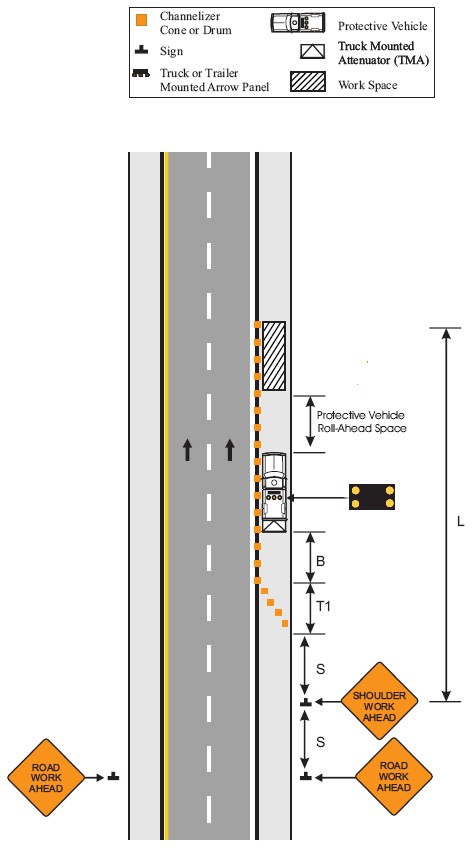
In addition to shoulder work, this typical application is applicable to work beyond shoulder where vehicles and equipment are parked on the shoulder.
A protective vehicle shall be used while work is in progress. The protective vehicle should be equipped with TMA and positioned at least 150 ft. in advance of the workspace.
If encroachment onto driving surface occurs and there is not 10 ft. of driving surface available for the lane of traffic, that traffic lane shall be closed. Refer to appropriate lane closure typical applications.
If an arrow panel is used for an operation on the shoulder, the caution mode shall be displayed.
For short duration or mobile operations, signs, channelization devices and protective vehicles may be reduced or eliminated if a work vehicle with activated rotating lights or strobe lights is used. However, if limited sight distance exists in a stationary operation or workers are on foot, a protective vehicle should be used. This protective vehicle should be equipped with a TMA and truck mounted flashing arrow panel and positioned at least 150 ft. in advance of the workspace or work vehicle, as applicable. If a protective vehicle is used, a vehicle-mounted sign shall be mounted at a recommended height of 48 in. above the road surface.
For work beyond shoulder, where vehicles and equipment are parked on the shoulder, the protective vehicle may be eliminated if a work vehicle with activated rotating lights or strobe lights is used.
Additional warning signs shall be erected at each intersection with another state highway within the work zone. Upon the discretion of the supervisor, additional warning signs may be erected at other intersections within the work zone.
Other appropriate signs may be used in lieu of SHOULDER WORK AHEAD sign.
| pdf. version of TA-4 |
| pdf. version of TA-4a |
616.23.3.4 TA-4 Mobile Operations on Two-Lane Highways
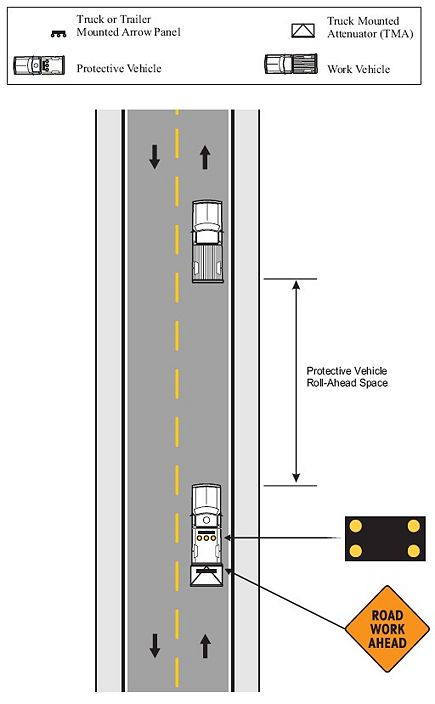
A protective vehicle shall be used when work is in progress. The protective vehicle shall be equipped with a vehicle-mounted sign and should be equipped with a TMA and flashing arrow panel.
For vehicle-mounted signs, a mounting height of 48 in. from the bottom of the sign to the road surface is recommended.
If the flashing arrow panel is used, the caution mode shall be displayed.
Where practical and when needed, the work and protective vehicles should pull over periodically to allow traffic to pass.
Whenever adequate stopping distance exists to the rear, the protective vehicle should be positioned at least 150 ft. in advance of the work vehicle and proceed at the same speed. The protective vehicle should slow down in advance of vertical or horizontal curves that restrict sight distance.
For mobile operations on roadways posted at 45 mph or below, the protective vehicle is optional provided the work vehicle uses activated rotating lights or strobe lights.
For mobile operations moving at a continuous speed within 15 mph of the posted speed and emergency snow removal operations, the protective vehicle is optional provided the work vehicle uses activated rotating lights or strobe lights.
For mobile operations where workers are on foot and move with the operation, the affected lane shall be closed. Refer to appropriate lane closure typical applications.
Other appropriate signs may be used in lieu of ROAD WORK AHEAD sign.
For pavement marking operations use the following figure (TA-4a).

| pdf. version of TA-5 |
| pdf. version of TA-5a |
| pdf. version of TA-5b |
| pdf. version of TA-5c |
| pdf. version of TA-5d |
616.23.3.5 TA-5 Mobile Operations on Divided or Multi-Lane Highways
Table 616.23.3.5
| Speed | Sign Spacing (ft.) | Taper Length (ft.) | Optional Buffer Length, B (ft.) | Channelizer Spacing (ft.) | |||
|---|---|---|---|---|---|---|---|
| Undivided, S | Divided, S | Shoulder, T1 1 | Lane, T2 2 | Tapers | Buffer/Work Areas | ||
| 0 - 35 | - | - | - | 245 | - | - | - |
| 40 - 45 | - | - | - | 540 | - | - | - |
| 50 - 55 | - | - | - | 660 | - | - | - |
| 60 - 70 | - | - | - | 840 | - | - | - |
| 1 Shoulder taper length based on 10 ft. (standard shoulder width) offset | |||||||
| 2 Lane taper length based on 12 ft. (standard lane width) offset | |||||||
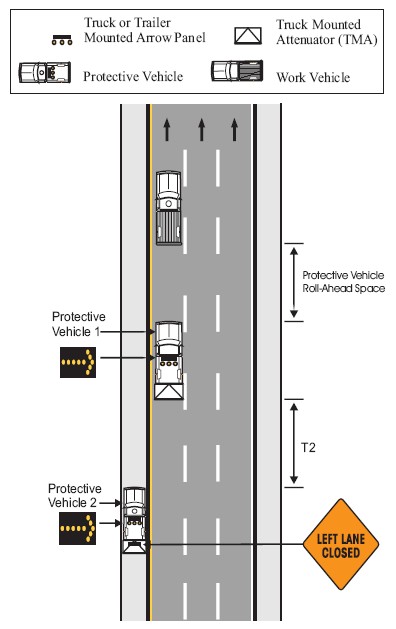
A protective vehicle occupying any portion of a lane shall be equipped with a flashing arrow panel and a TMA.
A protective vehicle on the shoulder shall be equipped with a flashing arrow panel. This protective vehicle should be equipped with a TMA.
Where adequate shoulder width is not available, Protective Vehicle 2, equipped with a TMA, may drive partially or fully in the lane.
Protective Vehicle 2 shall be equipped with an appropriate lane closure sign. A mounting height of 48 in. from the bottom of the sign to the road surface is recommended.
Protective Vehicle 1 should be positioned at least 150 ft. in advance of the work vehicle. This spacing may be minimized to deter traffic from driving in between the vehicles.
A third protective vehicle (not shown) may be used with Protective Vehicle 1 in the closed lane, Protective Vehicle 2 straddling the edge line, and Protective Vehicle 3 on the shoulder.
For interior lane closure, Protective Vehicles 1 and 2 shall travel in the same lane as the work vehicle. These vehicles shall be separated by at least 150 ft. A double-headed arrow shall be displayed on the flashing arrow panels. On high speed roadways, a third protective vehicle should drive the right shoulder. This vehicle shall be equipped with a flashing arrow panel and an appropriate advance lane closure sign and be positioned a distance of T2 from Protective Vehicle 2. The caution mode shall be displayed on the flashing arrow panel. A mounting height of 48 in. from the bottom of the sign to the road surface is recommended.
For mobile operations on roadways posted at 45 mph or below, the protective vehicles and TMAs are optional provided the work vehicle uses activated rotating lights or strobe lights.
For mobile operations moving at a continuous speed within 15 mph of the posted speed and emergency snow removal operations, the protective vehicles are optional provided the work vehicle uses activated rotating lights or strobe lights.
For mobile operations where workers are on foot and move with the operation, the affected lane shall be closed. Refer to appropriate lane closure typical applications.
Additional advanced warning signs should be used when there is not adequate shoulder.
Supplemental warning methods may be used to call attention to the work zone.
For pavement marking operations refer to the following Figures 616.23.3.5.1 (TA-5a) through 616.23.3.5.4 (TA-5d).




| pdf. version of TA-6 |
616.23.3.6 TA-6 Surveying Along Centerline of Low Volume, Two-Way Highways
Table 616.23.3.6.1
| Speed | Sign Spacing (ft.) | Taper Length (ft.) | Optional Buffer Length, B (ft.) | Channelizer Spacing (ft.) | |||
|---|---|---|---|---|---|---|---|
| Undivided, S | Divided, S | Shoulder, T1 1 | Lane, T2 2 | Tapers | Buffer/Work Areas | ||
| 0 - 35 | 200 | - | - | - | - | - | 50 |
| 40 - 45 | 350 | - | - | - | - | - | 100 |
| 50 - 55 | 500 | - | - | - | - | - | 100 |
| 60 - 70 | 1000 | - | - | - | - | - | 100 |
| 1 Shoulder taper length based on 10 ft. (standard shoulder width) offset | |||||||
| 2 Lane taper length based on 12 ft. (standard lane width) offset | |||||||
| Table 616.23.3.6.2 | ||
| Roadway Type | Sign Height | Max. Work Zone Length, L |
|---|---|---|
| Urban | 1 ft., Portable | 1 mile |
| 7 ft., Post | ||
| Rural Undivided | 1 ft., Portable | 3 miles |
| 5 ft., Post | ||
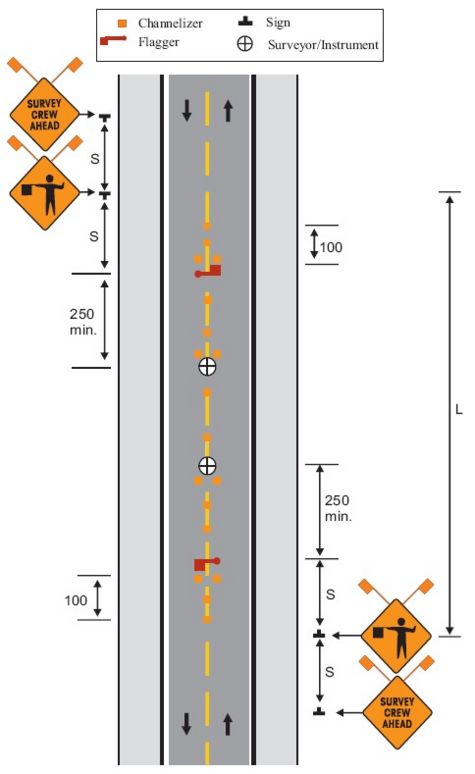
When surveying on road having an AADT of 500 or greater or when 10 ft. of driving surface cannot be maintained, one lane shall be closed. Refer to appropriate lane closure typical applications.
ROAD WORK AHEAD signs may be used in place of the SURVEY CREW AHEAD signs.
For short duration and mobile operations, signs and channelizing devices may be reduced or eliminated if a work vehicle with activated rotating lights or strobe lights is used.
For mobile operations, spacing between flagger and FLAGGER AHEAD sign shall not exceed one mile.
| pdf. version of TA-7 |
616.23.3.7 TA-7 Lane Closure on Two-Lane Highways Using Flaggers
Table 616.23.3.7.1
| Speed | Sign Spacing (ft.) | Taper Length (ft.) | Optional Buffer Length, B (ft.) | Channelizer Spacing (ft.) | |||
|---|---|---|---|---|---|---|---|
| Undivided, S | Divided, S | Shoulder, T1 1 | Lane, T2 2 | Tapers | Buffer/Work Areas | ||
| 0 - 35 | 200 | - | - | - | 120 | - | 50 |
| 40 - 45 | 350 | - | - | - | 220 | - | 100 |
| 50 - 55 | 500 | - | - | - | 335 | - | 100 |
| 60 - 70 | 1000 | - | - | - | 550 | - | 100 |
| 1 Shoulder taper length based on 10 ft. (standard shoulder width) offset | |||||||
| 2 Lane taper length based on 12 ft. (standard lane width) offset | |||||||
| Table 616.23.3.7.2 | ||
| Roadway Type | Sign Height | Max. Work Zone Length, L |
|---|---|---|
| Urban | 1 ft., Portable | 1 mile |
| 7 ft., Post | ||
| Rural Undivided | 1 ft., Portable | 3 miles |
| 5 ft., Post | ||
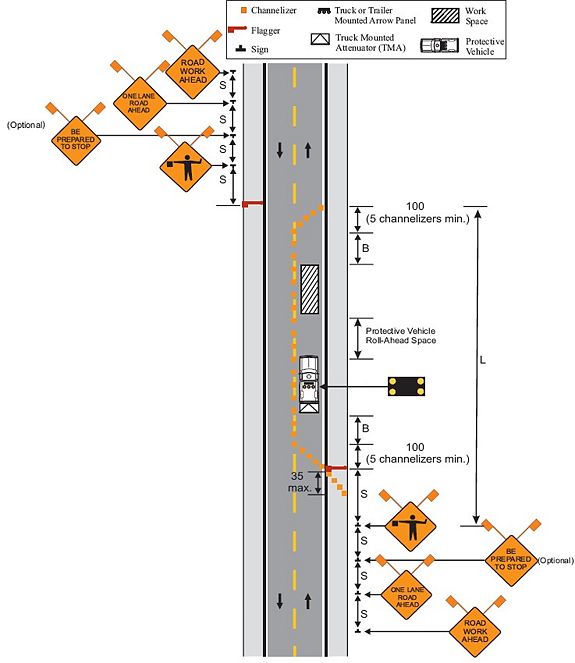
A protective vehicle shall be used while work is in progress. The protective vehicle should be equipped with a TMA and flashing arrow panel and positioned at least 150 ft. in advance of the workspace.
If a flashing arrow panel is used, the caution mode shall be displayed.
When a temporary road closure is needed, both directions may be stopped at the same time up to a maximum of 20 minutes.
Where operational conditions warrant, channelizing devices may be eliminated.
For short duration operations, signs and channelizers may be reduced or eliminated. The protective vehicle may be eliminated if adequate sight distance exists and the work vehicle uses activated rotating lights or strobe lights.
For mobile operations where workers are on foot and move with the operation, channelizers may be reduced or eliminated.
Additional warning signs shall be erected at each intersection with another state highway within the work zone. Upon the discretion of the supervisor, additional warning signs may be erected at other intersections within the work zone.
For mobile operations, spacing between flagger and FLAGGER AHEAD signs shall not exceed one mile.
| pdf. version of TA-8 |
616.23.3.8 TA-8 Lane Closure on Low-Volume, Two-Lane Highways
Table 616.23.3.8.1
| Speed | Sign Spacing (ft.) | Taper Length (ft.) | Optional Buffer Length, B (ft.) | Channelizer Spacing (ft.) | |||
|---|---|---|---|---|---|---|---|
| Undivided, S | Divided, S | Shoulder, T1 1 | Lane, T2 2 | Tapers | Buffer/Work Areas | ||
| 0 - 35 | 200 | - | - | - | 120 | - | 50 |
| 40 - 45 | 350 | - | - | - | 220 | - | 100 |
| 50 - 55 | 500 | - | - | - | 335 | - | 100 |
| 60 - 70 | 1000 | - | - | - | 550 | - | 100 |
| 1 Shoulder taper length based on 10 ft. (standard shoulder width) offset | |||||||
| 2 Lane taper length based on 12 ft. (standard lane width) offset | |||||||
| Table 616.23.3.8.2 | ||
| Roadway Type | Sign Height | Max. Work Zone Length, L |
|---|---|---|
| Urban | 1 ft., Portable | 1 mile |
| 7 ft., Post | ||
| Rural Undivided | 1 ft., Portable | 3 miles |
| 5 ft., Post | ||
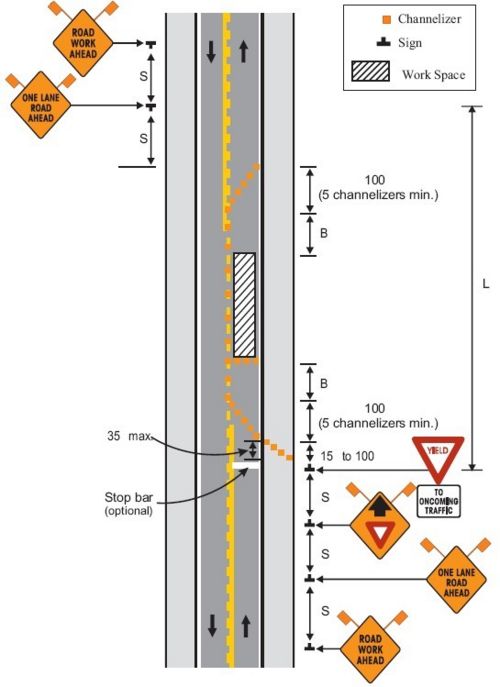
This typical application may be used as an alternate to the lane closure with flagger when all the following conditions exist:
- A. AADT less than 500.
- B. Drivers from both directions are able to see approaching traffic through and beyond the work site.
- C. Workers not present.
A Type B flashing warning light should be placed on the ROAD WORK AHEAD and the ONE LANE ROAD AHEAD signs whenever a night lane closure is necessary.
If the work zone is in place for more than 3 days, a stop bar shall be installed. Existing conflicting pavement markings and raised pavement marker reflectors between the activity area and the stop bar should be removed and temporary pavement markings installed as soon as practical. After the temporary traffic control is removed, the stop bar and other temporary pavement markings shall be removed and the permanent pavement markings restored as soon as practical.
Additional warning signs shall be erected at each intersection with another state highway within the work zone. Upon the discretion of the supervisor, additional warning signs may be erected at other intersections within the work zone.
| pdf. version of TA-9 |
616.23.3.9 TA-9 Lane Closure on Two-Lane Highways Using Traffic Control Signals
Table 616.23.3.9.1
| Speed | Sign Spacing (ft.) | Taper Length (ft.) | Optional Buffer Length, B (ft.) | Channelizer Spacing (ft.) | |||
|---|---|---|---|---|---|---|---|
| Undivided, S | Divided, S | Shoulder, T1 1 | Lane, T2 2 | Tapers | Buffer/Work Areas | ||
| 0 - 35 | 200 | - | - | - | 120 | - | 50 |
| 40 - 45 | 350 | - | - | - | 220 | - | 100 |
| 50 - 55 | 500 | - | - | - | 335 | - | 100 |
| 60 - 70 | 1000 | - | - | - | 550 | - | 100 |
| 1 Shoulder taper length based on 10 ft. (standard shoulder width) offset | |||||||
| 2 Lane taper length based on 12 ft. (standard lane width) offset | |||||||
| Table 616.23.3.9.2 | ||
| Roadway Type | Sign Height | Max. Work Zone Length, L |
|---|---|---|
| Urban | 1 ft., Portable | 1 mile |
| 7 ft., Post | ||
| Rural Undivided | 1 ft., Portable | 3 miles |
| 5 ft., Post | ||
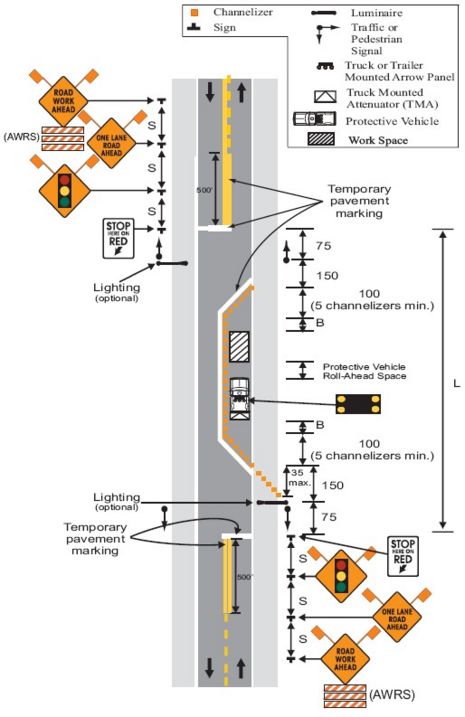
A protective vehicle shall be used while work is in progress. The protective vehicle should be equipped with a TMA and flashing arrow panel and positioned at least 150 ft. in advance of the workspace.
If a flashing arrow panel is used, the caution mode shall be displayed.
Temporary traffic control signals shall be installed and operated in accordance with the provisions of 902 Signals.
Temporary traffic control signals shall meet the physical display and operational requirements of conventional traffic control signals.
The Traffic Engineer shall approve temporary traffic control signal timing.
Trailer-mounted signals may be used in lieu of span wire signals. A Type B warning light should be placed on the ROAD WORK AHEAD and the ONE LANE ROAD AHEAD signs whenever a night lane closure is necessary.
If the work zone is in place for more than 3 days, a stop bar shall be installed. Existing conflicting pavement markings and raised pavement marker reflectors between the activity area and the stop bar should be removed and temporary pavement markings installed as soon as practical. After the temporary traffic control is removed, the stop bar and other temporary pavement markings shall be removed and the permanent pavement markings restored as soon as practical.
Additional warning signs shall be erected at each intersection with another state highway within the work zone. Upon the discretion of the supervisor, additional warning signs may be erected at other intersections within the work zone.
| pdf. version of TA-10 |
616.23.3.10 TA-10 Operations in Two-Way Left Turn Lane on Multilane Undivided Highways
Table 616.23.3.10.1
| Speed | Sign Spacing (ft.) | Taper Length (ft.) | Optional Buffer Length, B (ft.) | Channelizer Spacing (ft.) | |||
|---|---|---|---|---|---|---|---|
| Undivided, S | Divided, S | Shoulder, T1 1 | Lane, T2 2 | Tapers | Buffer/Work Areas | ||
| 0 - 35 | 200 | - | - | - | 120 | - | 50 |
| 40 - 45 | 350 | - | - | - | 220 | - | 100 |
| 50 - 55 | 500 | - | - | - | 335 | - | 100 |
| 60 - 70 | 1000 | - | - | - | 550 | - | 100 |
| 1 Shoulder taper length based on 10 ft. (standard shoulder width) offset | |||||||
| 2 Lane taper length based on 12 ft. (standard lane width) offset | |||||||
| Table 616.23.3.10.2 | ||
| Roadway Type | Sign Height | Max. Work Zone Length, L |
|---|---|---|
| Urban | 1 ft., Portable | 1 mile |
| 7 ft., Post | ||
| Rural Undivided | 1 ft., Portable | 3 miles |
| 5 ft., Post | ||
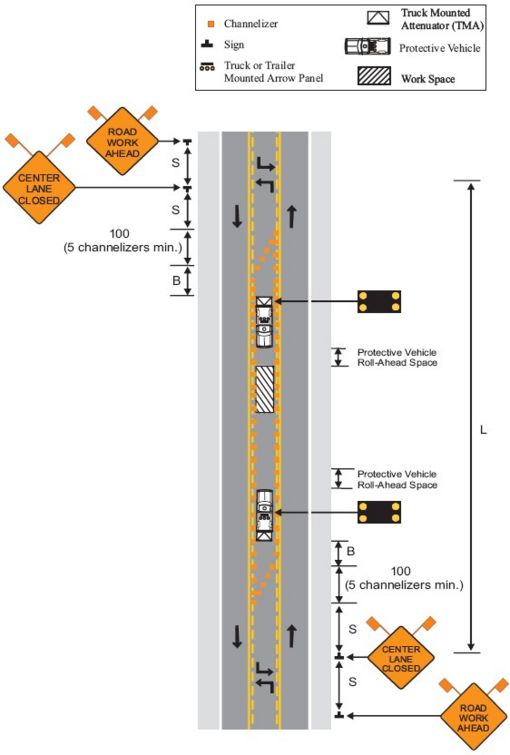
A protective vehicle shall be used in each direction while work is in progress. Each protective vehicle should be equipped with a TMA and flashing arrow panel and positioned at least 150 ft. in advance of the work space.
If a flashing arrow panel is used, the caution mode shall be displayed.
Channelizer spacing may be reduced to discourage turning traffic from entering into the activity area.
For short duration and mobile operations, signs and channelizers may be reduced or eliminated. One protective vehicle may be eliminated if the roadway is posted at 45 mph or below, the workspace is located between the remaining protective vehicle and a work vehicle, and both vehicles use activated rotating lights or strobe lights.
For mobile operations where workers are on foot and move with the operation, channelizers may be reduced or eliminated. One protective vehicle may be eliminated if the roadway is posted at 45 mph or below, the workspace is located between the remaining protective vehicle and a work vehicle, and both vehicles use activated lights or strobe lights.
Additional warning signs shall be erected at each intersection with another state highway within the work zone. Upon the discretion of the supervisor, additional warning signs may be erected at other intersections within the work zone.
| pdf. version of TA-11 |
616.23.3.11 TA-11 Lane Closure on Multilane Undivided Highways
Table 616.23.3.11.1
| Speed | Sign Spacing (ft.) | Taper Length (ft.) | Optional Buffer Length, B (ft.) | Channelizer Spacing (ft.) | |||
|---|---|---|---|---|---|---|---|
| Undivided, S | Divided, S | Shoulder, T1 1 | Lane, T2 2 | Tapers | Buffer/Work Areas | ||
| 0 - 35 | 200 | - | - | 245 | 120 | 35 | 50 |
| 40 - 45 | 350 | - | - | 540 | 220 | 40 | 100 |
| 50 - 55 | 500 | - | - | 660 | 335 | 50 | 100 |
| 60 - 70 | 1000 | - | - | 840 | 550 | 60 | 100 |
| 1 Shoulder taper length based on 10 ft. (standard shoulder width) offset | |||||||
| 2 Lane taper length based on 12 ft. (standard lane width) offset | |||||||
| Table 616.23.3.11.2 | ||
| Roadway Type | Sign Height | Max. Work Zone Length, L |
|---|---|---|
| Urban | 1 ft., Portable | 1 mile |
| 7 ft., Post | ||
| Rural Undivided | 1 ft., Portable | 3 miles |
| 5 ft., Post | ||
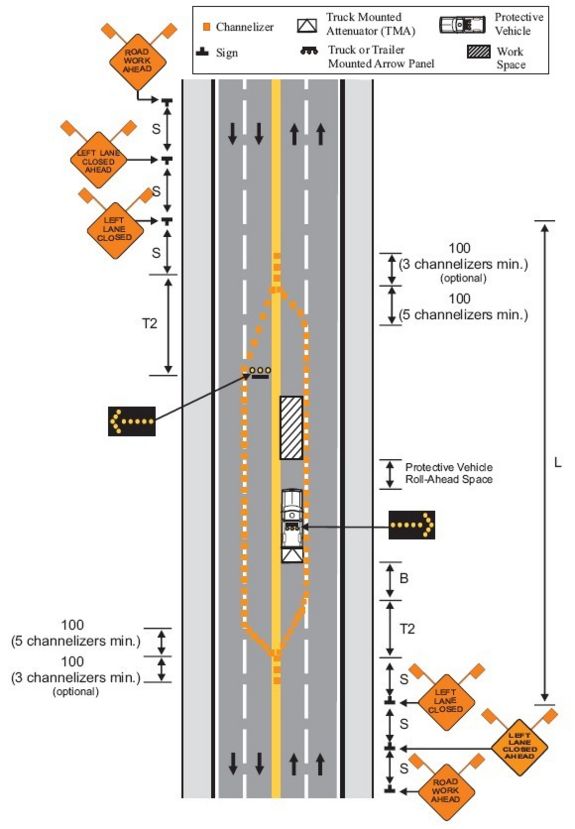
A protective vehicle shall be used while work is in progress. The protective vehicle should be equipped with a TMA and flashing arrow panel and positioned at least 150 ft. in advance of the workspace. The protective vehicle may be eliminated if the roadway is posted at 45 mph or below, the work vehicle is positioned in advance of the workspace, and the work vehicle uses activated rotating lights or strobe lights.
The closure of the adjacent interior lane in the opposing direction may not be necessary, depending upon the activity being performed and the workspace needed for the operation.
If physical barriers exist (i.e. guardrail, guard cable, concrete barrier or raised median) between opposing directions of traffic, refer to 616.23.3.12 TA-12 Lane Closure on Left or Right Lane on Divided Highways.
For short duration operations, signs and channelizers may be reduced or eliminated.
For mobile operations where workers are on foot and move with the operation, channelizers may be reduced or eliminated.
Additional warning signs shall be erected at each intersection with another state highway within the work zone. Upon the discretion of the supervisor, additional warning signs may be erected at other intersections within the work zone.
| pdf. version of TA-12 |
616.23.3.12 TA-12 Lane Closure on Left or Right Lane on Divided Highways
Table 616.23.3.12.1
| Speed | Sign Spacing (ft.) | Taper Length (ft.) | Optional Buffer Length, B (ft.) | Channelizer Spacing (ft.) | |||
|---|---|---|---|---|---|---|---|
| Undivided, S | Divided, S | Shoulder, T1 1 | Lane, T2 2 | Tapers | Buffer/Work Areas | ||
| 0 - 35 | - | 200 | 70 | 245 | 120 | 35 | 50 |
| 40 - 45 | - | 500 | 150 | 540 | 220 | 40 | 100 |
| 50 - 55 | - | 1000 | 185 | 660 | 335 | 50 | 100 |
| 60 - 70 | - | 1000 | 235 | 840 | 550 | 60 | 100 |
| 1 Shoulder taper length based on 10 ft. (standard shoulder width) offset | |||||||
| 2 Lane taper length based on 12 ft. (standard lane width) offset | |||||||
| Table 616.23.3.12.2 | ||
| Roadway Type | Sign Height | Max. Work Zone Length, L |
|---|---|---|
| Urban | 1 ft., Portable | 1 mile |
| 7 ft., Post | ||
| Rural Divided | 1 ft., Portable | 2 miles |
| 7 ft., Post | ||
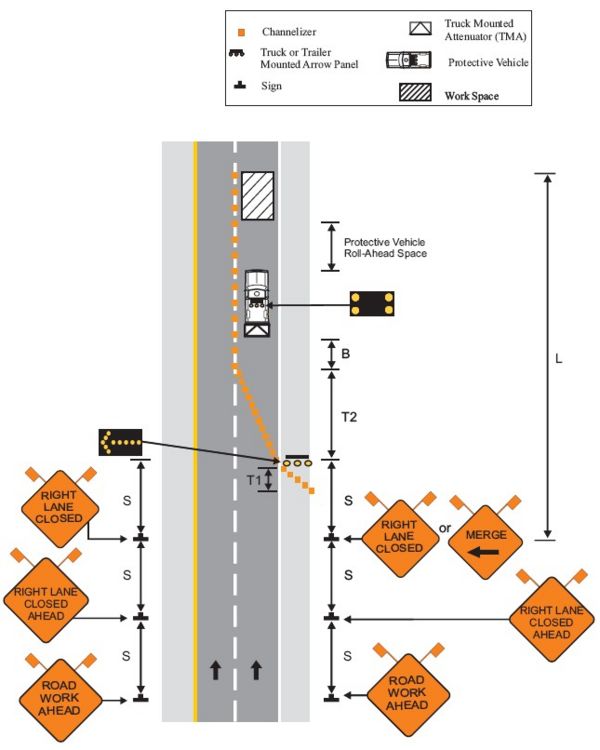
A protective vehicle shall be used while work is in progress. The protective vehicle shall be equipped with a TMA and flashing arrow panel and positioned at least 150 ft. in advance of the workspace. The protective vehicle may be eliminated if the roadway is posted at 45 mph or below, the work vehicle is positioned in advance of the work space, and the work vehicle is equipped with a flashing arrow panel and uses activated rotating lights or strobe lights.
All vehicles, equipment, workers and their activities should be restricted to one side of the pavement.
The open lane shall be provided with a 10 ft. minimum driving surface at all times. This may include a portion of the shoulder, provided the shoulder is of adequate strength to handle traffic.
For short duration operations, signs and channelizers may be reduced or eliminated.
For mobile operations where workers are on foot and move with the operation, channelizers may be reduced or eliminated.
For operations in which channelizers are not used, the arrow mode shall be displayed on any flashing arrow panel located downstream of the taper.
Supplemental warning methods may be used to call attention to the work zone.
Additional warning signs shall be erected at each intersection with another state highway within the work zone. Upon the discretion of the supervisor, additional warning signs may be erected at other intersections within the work zone.
| pdf. version of TA-13 |
616.23.3.13 TA-13 Lane Closure of Interior Lane on Multilane Highways
Table 616.23.3.13.1
| Speed | Sign Spacing (ft.) | Taper Length (ft.) | Optional Buffer Length, B (ft.) | Longitudinal Transition, X | Channelizer Spacing (ft.) | |||
|---|---|---|---|---|---|---|---|---|
| Undivided, S | Divided, S | Shoulder, T1 1 | Lane, T2 2 | Tapers | Buffer/Work Areas | |||
| 0 - 35 | 200 | 200 | 70 | 245 | 120 | 480 | 35 | 50 |
| 40 - 45 | 350 | 500 | 150 | 540 | 220 | 1080 | 40 | 100 |
| 50 - 55 | 500 | 1000 | 185 | 660 | 335 | 1320 | 50 | 100 |
| 60 - 70 | 1000 | 1000 | 235 | 840 | 550 | 1680 | 60 | 100 |
| 1 Shoulder taper length based on 10 ft. (standard shoulder width) offset | ||||||||
| 2 Lane taper length based on 12 ft. (standard lane width) offset | ||||||||
| Table 616.23.3.13.2 | ||
| Roadway Type | Sign Height | Max. Work Zone Length, L |
|---|---|---|
| Urban | 1 ft., Portable | 1 mile |
| 7 ft., Post | ||
| Rural Divided | 1 ft., Portable | 2 miles |
| 7 ft., Post | ||
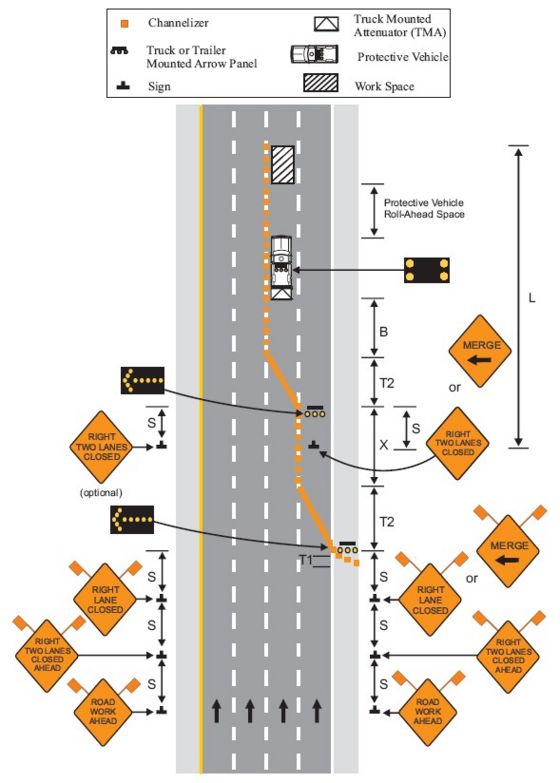
This typical application applies to lane closures of lane 2 of 3, lanes 2 or 3 of 4, lanes 2 or 4 of 5, lanes 2 or 5 of 6, and lanes 2 or 6 of 7.
This typical application is applicable to work being performed when capacity is not an issue. If capacity is an issue, refer to 616.23.3.14 Lane Closure of Interior Lane on Multilane Highways for Capacity .
A protective vehicle shall be used while work is in progress. The protective vehicle shall be equipped with a TMA and flashing arrow panel and positioned at least 150 ft. in advance of the workspace.
Supplemental warning methods may be used to call attention to the work zone.
Signs shown on the left side of this typical application may be omitted on undivided highways.
| pdf. version of TA-14 |
616.23.3.14 TA-14 Lane Closure of Interior Lane on Multilane Highways for Capacity
Table 616.23.3.14.1
| Speed | Sign Spacing (ft.) | Taper Length (ft.) | Optional Buffer Length, B (ft.) | Longitudinal Transition, X | Channelizer Spacing (ft.) | |||
|---|---|---|---|---|---|---|---|---|
| Undivided, S | Divided, S | Shoulder, T1 1 | Lane, T2 2 | Tapers | Buffer/Work Areas | |||
| 0 - 35 | 200 | 200 | 70 | 245 | 120 | 480 | 35 | 50 |
| 40 - 45 | 350 | 500 | 150 | 540 | 220 | 1080 | 40 | 100 |
| 50 - 55 | 500 | 1000 | 185 | 660 | 335 | 1320 | 50 | 100 |
| 60 - 70 | 1000 | 1000 | 235 | 840 | 550 | 1680 | 60 | 100 |
| 1 Shoulder taper length based on 10 ft. (standard shoulder width) offset | ||||||||
| 2 Lane taper length based on 12 ft. (standard lane width) offset | ||||||||
| Table 616.23.3.14.2 | ||
| Roadway Type | Sign Height | Max. Work Zone Length, L |
|---|---|---|
| Urban | 1 ft., Portable | 1 mile |
| 7 ft., Post | ||
| Rural Divided | 1 ft., Portable | 2 miles |
| 7 ft., Post | ||
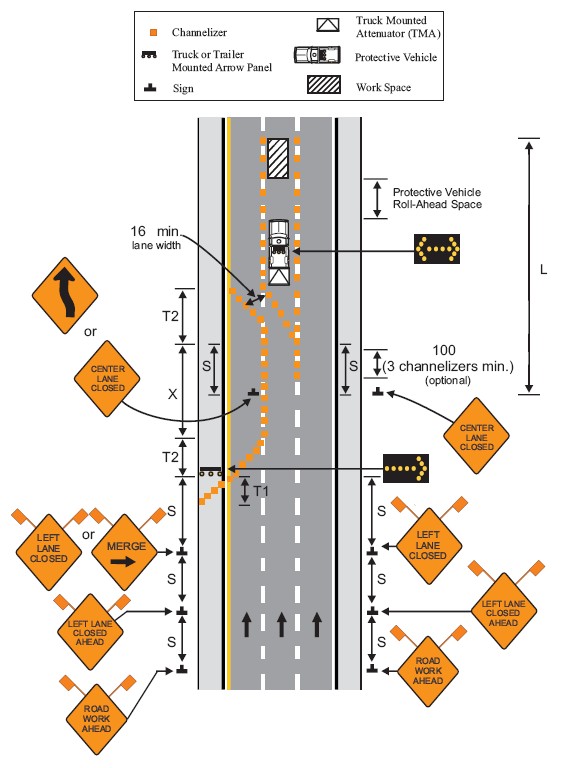
This typical application applies to lane closures of lane 2 of 3, lanes 2 or 3 of 4, lanes 2 or 4 of 5, lanes 2 or 5 of 6, and lanes 2 or 6 of 7.
This typical application is applicable to work being performed when capacity is an issue. If capacity is not an issue, refer to 616.23.3.13 TA-13 Lane Closure of Interior Lane on Multilane Highways.
A protective vehicle shall be used while work is in progress. The protective vehicle shall be equipped with a TMA and flashing arrow panel and positioned at least 150 ft. in advance of the workspace.
As an alternative to initially closing the left lane, as shown in the typical application, the right lane may be closed with appropriate channelization and signs.
Supplemental warning methods may be used to call attention to the work zone.
Signs shown on the left side of this typical application may be omitted on undivided highways.
| pdf. version of TA-15 |
| pdf. version of TA-15a |
616.23.3.15 TA-15 Lane Closure of Interior Lane on Multilane Divided Highways
Table 616.23.3.15.1
| Speed | Sign Spacing (ft.) | Taper Length (ft.) | Optional Buffer Length, B (ft.) | Longitudinal Transition, X | Channelizer Spacing (ft.) | |||
|---|---|---|---|---|---|---|---|---|
| Undivided, S | Divided, S | Shoulder, T1 1 | Lane, T2 2 | Tapers | Buffer/Work Areas | |||
| 0 - 35 | 200 | 200 | 70 | 245 | 120 | 480 | 35 | 50 |
| 40 - 45 | 350 | 500 | 150 | 540 | 220 | 1080 | 40 | 100 |
| 50 - 55 | 500 | 1000 | 185 | 660 | 335 | 1320 | 50 | 100 |
| 60 - 70 | 1000 | 1000 | 235 | 840 | 550 | 1680 | 60 | 100 |
| 1 Shoulder taper length based on 10 ft. (standard shoulder width) offset | ||||||||
| 2 Lane taper length based on 12 ft. (standard lane width) offset | ||||||||
| Table 616.23.3.15.2 | ||
| Roadway Type | Sign Height | Max. Work Zone Length, L |
|---|---|---|
| Urban | 1 ft., Portable | 1 mile |
| 7 ft., Post | ||
| Rural Divided | 1 ft., Portable | 2 miles |
| 7 ft., Post | ||
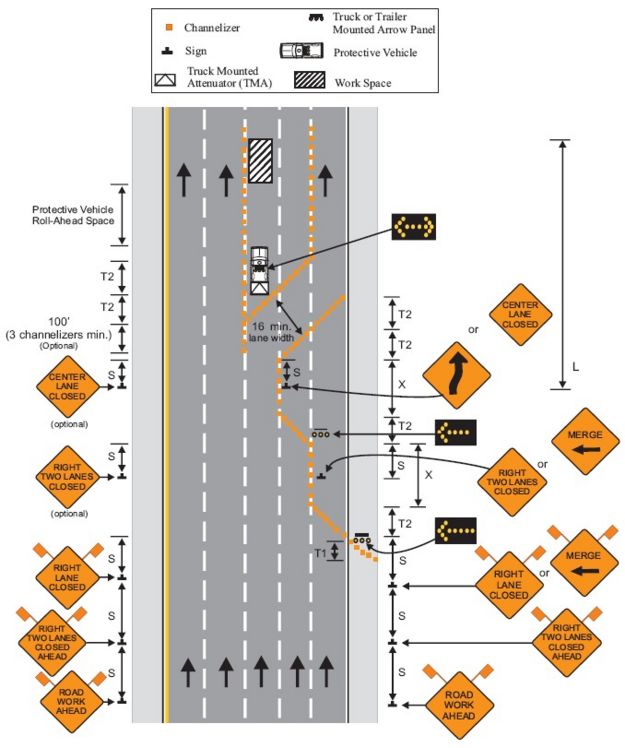
This typical application applies to lane closures of lane 3 of 5, lanes 3 or 4 of 6, and lanes 3 or 5 of 7.
A protective vehicle shall be used while work is in progress. The protective vehicle shall be equipped with a TMA and flashing arrow panel and positioned at least 150 ft. in advance of the workspace.
As an alternative to initially closing the right two lanes, as shown in the typical application, the left two lanes may be closed with appropriate channelization and signs.
Supplemental warning methods may be used to call attention to the work zone.
This typical application applies to lane closures of lane 3 of 5, lanes 3 or 4 of 6, and lanes 3 or 5 of 7.
Protective vehicles shall be used while work is in progress. Each protective vehicle shall be equipped with a TMA and flashing arrow panel and positioned at least 150 ft. in advance of the workspace.
As an alternative to initially closing the right two lanes, as shown in the typical application, the left two lanes may be closed with appropriate channelization and signs.
Supplemental warning methods may be used to call attention to the work zone.
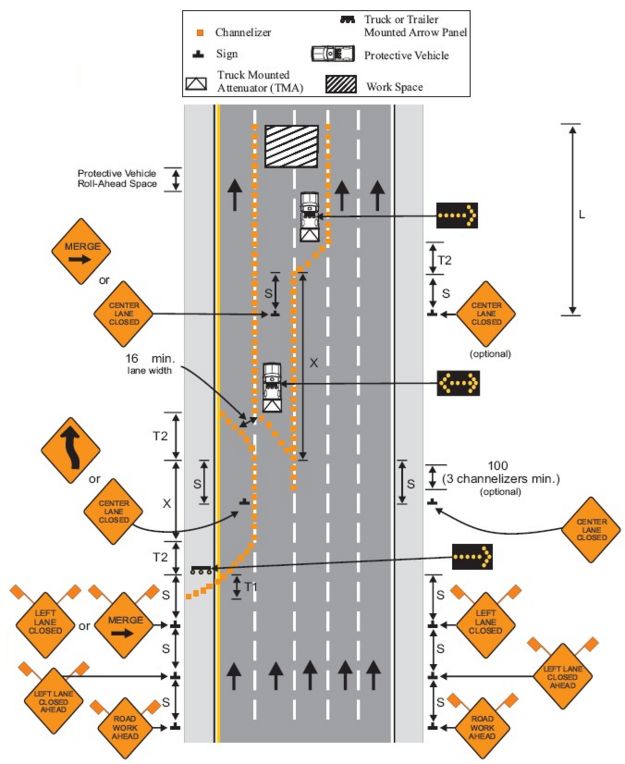
| pdf. version of TA-16 |
616.23.3.16 TA-16 Lane Closure of Interior Lane on Multilane Divided Highways
Table 616.23.3.16.1
| Speed | Sign Spacing (ft.) | Taper Length (ft.) | Optional Buffer Length, B (ft.) | Longitudinal Transition, X | Channelizer Spacing (ft.) | |||
|---|---|---|---|---|---|---|---|---|
| Undivided, S | Divided, S | Shoulder, T1 1 | Lane, T2 2 | Tapers | Buffer/Work Areas | |||
| 0 - 35 | 200 | 200 | 70 | 245 | 120 | 480 | 35 | 50 |
| 40 - 45 | 350 | 500 | 150 | 540 | 220 | 1080 | 40 | 100 |
| 50 - 55 | 500 | 1000 | 185 | 660 | 335 | 1320 | 50 | 100 |
| 60 - 70 | 1000 | 1000 | 235 | 840 | 550 | 1680 | 60 | 100 |
| 1 Shoulder taper length based on 10 ft. (standard shoulder width) offset | ||||||||
| 2 Lane taper length based on 12 ft. (standard lane width) offset | ||||||||
| Table 616.23.3.16.2 | ||
| Roadway Type | Sign Height | Max. Work Zone Length, L |
|---|---|---|
| Urban | 1 ft., Portable | 1 mile |
| 7 ft., Post | ||
| Rural Divided | 1 ft., Portable | 2 miles |
| 7 ft., Post | ||
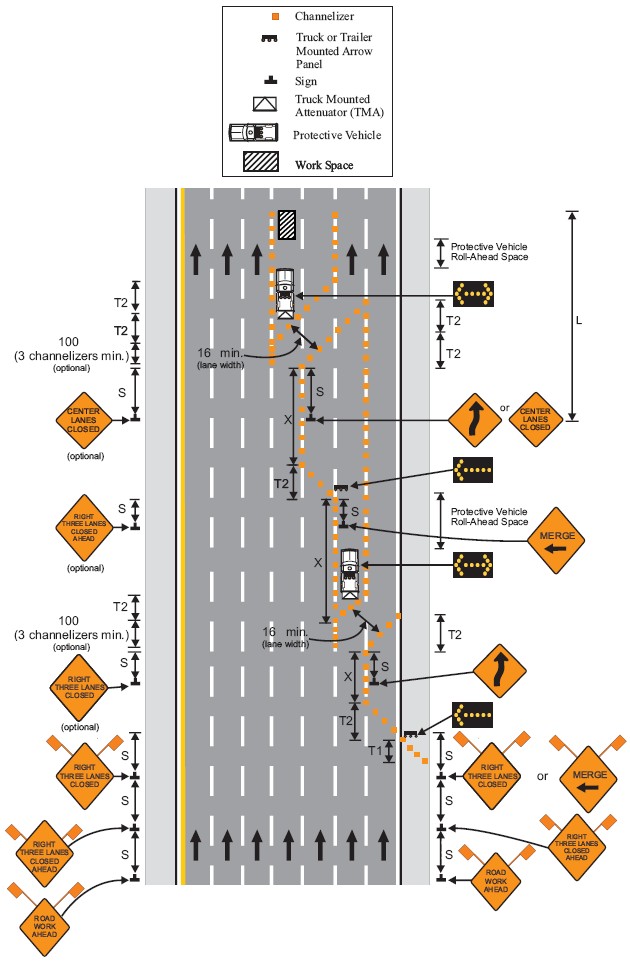
This typical application applies to a lane closure of lane 4 of 7.
Protective vehicles shall be used while work is in progress. Each protective vehicle shall be equipped with a TMA and flashing arrow panel and positioned at least 150 ft. in advance of the workspace and other equipment.
As an alternative to initially closing the right three lanes, as shown in the typical application, the left three lanes may be closed with appropriate channelization and signs.
Supplemental warning methods may be used to call attention to the work zone.
| pdf. version of TA-17 |
616.23.3.17 TA-17 Work in Vicinity of Exit Ramp
Table 616.23.3.17.1
| Speed | Sign Spacing (ft.) | Taper Length (ft.) | Optional Buffer Length, B (ft.) | Channelizer Spacing (ft.) | |||
|---|---|---|---|---|---|---|---|
| Undivided, S | Divided, S | Shoulder, T1 1 | Lane, T2 2 | Tapers | Buffer/Work Areas | ||
| 0 - 35 | - | 200 | 70 | 245 | 120 | 35 | 50 |
| 40 - 45 | - | 500 | 150 | 540 | 220 | 40 | 100 |
| 50 - 55 | - | 1000 | 185 | 660 | 335 | 50 | 100 |
| 60 - 70 | - | 1000 | 235 | 840 | 550 | 60 | 100 |
| 1 Shoulder taper length based on 10 ft. (standard shoulder width) offset | |||||||
| 2 Lane taper length based on 12 ft. (standard lane width) offset | |||||||
| Table 616.23.3.17.2 | ||
| Roadway Type | Sign Height | Max. Work Zone Length, L |
|---|---|---|
| Urban | 1 ft., Portable | 1 mile |
| 7 ft., Post | ||
| Rural Divided | 1 ft., Portable | 2 miles |
| 7 ft., Post | ||
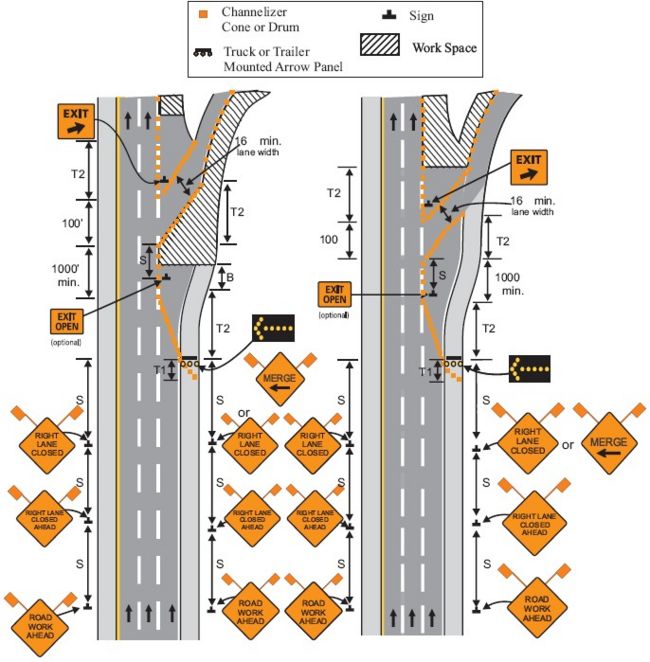
A protective vehicle, not shown, shall be used when work is in progress. The protective vehicle shall be equipped with a TMA and positioned at least 150 ft. in advance of the workspace.
A temporary EXIT sign shall be located in the temporary gore to indicate that the ramp is open, and where the temporary ramp is located. This sign shall be mounted at 7 ft. However, if the ramp is closed, guide signs should indicate this condition. A black on orange EXIT CLOSED panel should be placed diagonally across the advance EXIT guide signs.
Channelizers immediately in advance of and after the temporary EXIT should be spaced at ½ spacing.
For work entirely within the deceleration lane, the signs, channelizers and flashing arrow panel necessary for the through-lane lane closure may be eliminated.
Supplemental warning methods may be used to call attention to the work zone.
| pdf. version of TA-18 |
616.23.3.18 TA-18 Work in Vicinity of Entrance Ramp
Table 616.23.3.18.1
| Speed | Sign Spacing (ft.) | Taper Length (ft.) | Optional Buffer Length, B (ft.) | Channelizer Spacing (ft.) | |||
|---|---|---|---|---|---|---|---|
| Undivided, S | Divided, S | Shoulder, T1 1 | Lane, T2 2 | Tapers | Buffer/Work Areas | ||
| 0 - 35 | - | 200 | 70 | 245 | 120 | 35 | 50 |
| 40 - 45 | - | 500 | 150 | 540 | 220 | 40 | 100 |
| 50 - 55 | - | 1000 | 185 | 660 | 335 | 50 | 100 |
| 60 - 70 | - | 1000 | 235 | 840 | 550 | 60 | 100 |
| 1 Shoulder taper length based on 10 ft. (standard shoulder width) offset | |||||||
| 2 Lane taper length based on 12 ft. (standard lane width) offset | |||||||
| Table 616.23.3.18.2 | ||
| Roadway Type | Sign Height | Max. Work Zone Length, L |
|---|---|---|
| Urban | 1 ft., Portable | 1 mile |
| 7 ft., Post | ||
| Rural Divided | 1 ft., Portable | 2 miles |
| 7 ft., Post | ||
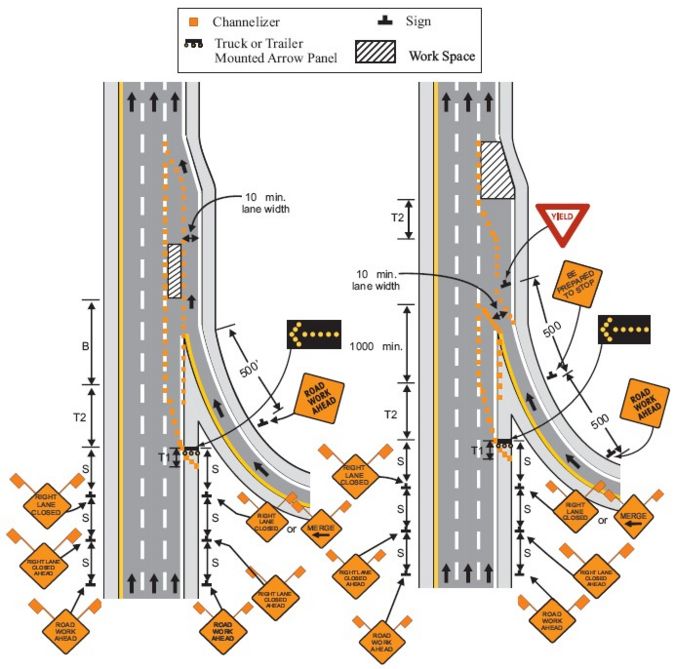
A protective vehicle, not shown, shall be used when work is in progress. The protective vehicle shall be equipped with a TMA and positioned at least 150 ft. in advance of the workspace.
Where inadequate acceleration distance exists for the temporary entrance shown on the right diagram, the YIELD sign may be replaced with STOP signs (one on each side of the approach).
When used, the YIELD or STOP sign should be located so ramp traffic has adequate sight distance to merge into mainline traffic. If insufficient gaps are available, consideration should be given to closing the ramp.
Where STOP signs are used, a temporary stop bar should be placed across the ramp at the desired stop location.
For work entirely within the acceleration lane, the signs, channelizers and flashing arrow panel necessary for the through-lane lane closure may be eliminated.
Supplemental warning methods may be used to call attention to the work zone.
| pdf. version of TA-19 |
616.23.3.19 TA-19 Lane Closure at Interchange
Table 616.23.3.19.1
| Speed | Sign Spacing (ft.) | Taper Length (ft.) | Optional Buffer Length, B (ft.) | Channelizer Spacing (ft.) | |||
|---|---|---|---|---|---|---|---|
| Undivided, S | Divided, S | Shoulder, T1 1 | Lane, T2 2 | Tapers | Buffer/Work Areas | ||
| 0 - 35 | 200 | 200 | 70 | 245 | 120 | 35 | 50 |
| 40 - 45 | 350 | 500 | 150 | 540 | 220 | 40 | 100 |
| 50 - 55 | 500 | 1000 | 185 | 660 | 335 | 50 | 100 |
| 60 - 70 | 1000 | 1000 | 235 | 840 | 550 | 60 | 100 |
| 1 Shoulder taper length based on 10 ft. (standard shoulder width) offset | |||||||
| 2 Lane taper length based on 12 ft. (standard lane width) offset | |||||||
| Table 616.23.3.19.2 | ||
| Roadway Type | Sign Height | Max. Work Zone Length, L |
|---|---|---|
| Urban | 1 ft., Portable | 1 mile |
| 7 ft., Post | ||
| Rural Divided | 1 ft., Portable | 2 miles |
| 7 ft., Post | ||
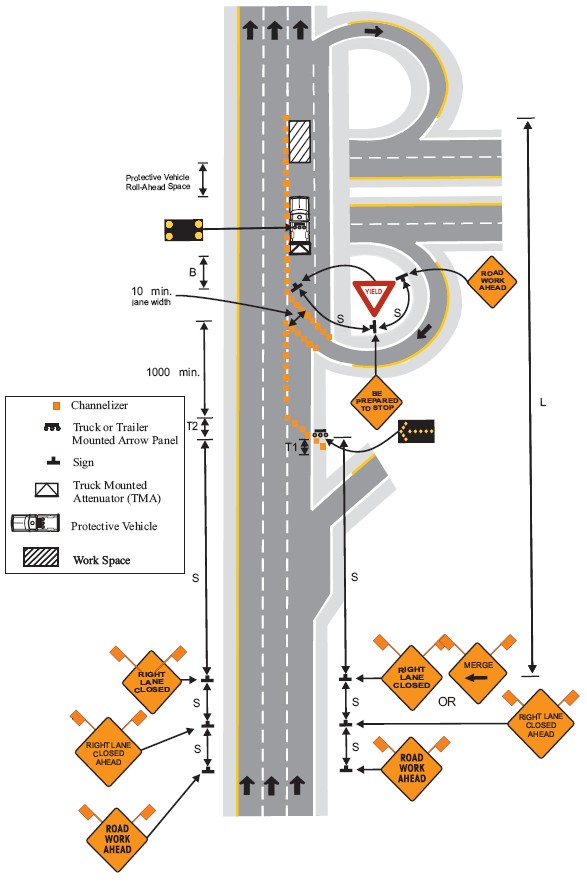
A protective vehicle shall be used when work is in progress. The protective vehicle shall be equipped with a TMA and flashing arrow panel at least 150 ft. in advance of the workspace.
If an exit ramp is located within the limits of the lane drop, temporary exit signing and channelizers shall be provided as shown on 616.23.3.17 TA-17 Work in Vicinity of Exit Ramp.
Where inadequate acceleration distance exists for the temporary entrance, the YIELD sign may be replaced with STOP signs (one on each side of the approach).
When used, the YIELD or STOP sign should be located so that ramp traffic has adequate sight distance to merge into mainline traffic. If insufficient gaps are available, consideration should be given to closing the ramp.
Where STOP signs are used, a temporary stop bar should be placed across the ramp at the desired stop location.
For work entirely within the acceleration/deceleration lane, the signs, channelizers and flashing arrow panel necessary for the through-lane lane closure may be eliminated.
Supplemental warning methods may be used to call attention to the work zone.
| pdf. version of TA-20 |
616.23.3.20 TA-20 Work on Ramps
Table 616.23.3.20.1
| Speed | Sign Spacing (ft.) | Taper Length (ft.) | Optional Buffer Length, B (ft.) | Channelizer Spacing (ft.) | |||
|---|---|---|---|---|---|---|---|
| Undivided, S | Divided, S | Shoulder, T1 1 | Lane, T2 2 | Tapers | Buffer/Work Areas | ||
| 0 - 35 | - | 200 | 70 | 245 | 120 | 35 | 50 |
| 40 - 45 | - | 500 | 150 | 540 | 220 | 40 | 100 |
| 50 - 55 | - | 1000 | 185 | 660 | 335 | 50 | 100 |
| 60 - 70 | - | 1000 | 235 | 840 | 550 | 60 | 100 |
| 1 Shoulder taper length based on 10 ft. (standard shoulder width) offset | |||||||
| 2 Lane taper length based on 12 ft. (standard lane width) offset | |||||||
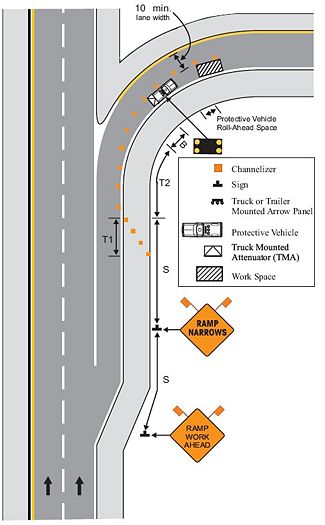
This typical application is applicable to work being performed on ramps only. For work affecting acceleration and deceleration lanes, refer to 616.23.3.17 TA-17 Work in Vicinity of Exit Ramp, 616.23.3.18 TA-18 Work in Vicinity of Entrance Ramp or 616.23.3.19 TA-19 Lane Closure at Interchange.
| Table 616.23.3.20.2 | ||
| Roadway Type | Sign Height | Max. Work Zone Length, L |
|---|---|---|
| Urban | 1 ft., Portable | 1 mile |
| 7 ft., Post | ||
| Rural Divided | 1 ft., Portable | 2 miles |
| 7 ft., Post | ||
A protective vehicle shall be used when work is in progress. The protective vehicle should be equipped with a TMA and positioned at least 150 ft. in advance of the workspace.
The ramp lane shall be provided with a 10 ft. minimum driving surface at all times. This may include a portion of the shoulder, provided the shoulder is of adequate strength to handle traffic.
| pdf. version of TA-21 |
616.23.3.21 TA-21 Lane Closure of Left Lane on Far Side of Intersection
Table 616.23.3.21.1
| Speed | Sign Spacing (ft.) | Taper Length (ft.) | Optional Buffer Length, B (ft.) | Longitudinal Transition, X | Channelizer Spacing (ft.) | |||
|---|---|---|---|---|---|---|---|---|
| Undivided, S | Divided, S | Shoulder, T1 1 | Lane, T2 2 | Tapers | Buffer/Work Areas | |||
| 0 - 35 | 200 | 200 | - | 245 | 120 | 120 | 15 | 25 |
| 40 - 45 | 350 | 500 | - | 540 | 220 | 270 | 20 | 50 |
| 50 - 55 | 500 | 1000 | - | 660 | 335 | 330 | 50 | 100 |
| 60 - 70 | 1000 | 1000 | - | 840 | 550 | 420 | 60 | 100 |
| 1 Shoulder taper length based on 10 ft. (standard shoulder width) offset | ||||||||
| 2 Lane taper length based on 12 ft. (standard lane width) offset | ||||||||
| Table 616.23.3.21.2 | ||
| Roadway Type | Sign Height | Max. Work Zone Length, L |
|---|---|---|
| Urban | 1 ft., Portable | 1 mile |
| 7 ft., Post | ||
| Rural Divided | 1 ft., Portable | 2 miles |
| 7 ft., Post | ||
| Rural Undivided | 1 ft., Portable | 3 miles |
| 5 ft., Post | ||
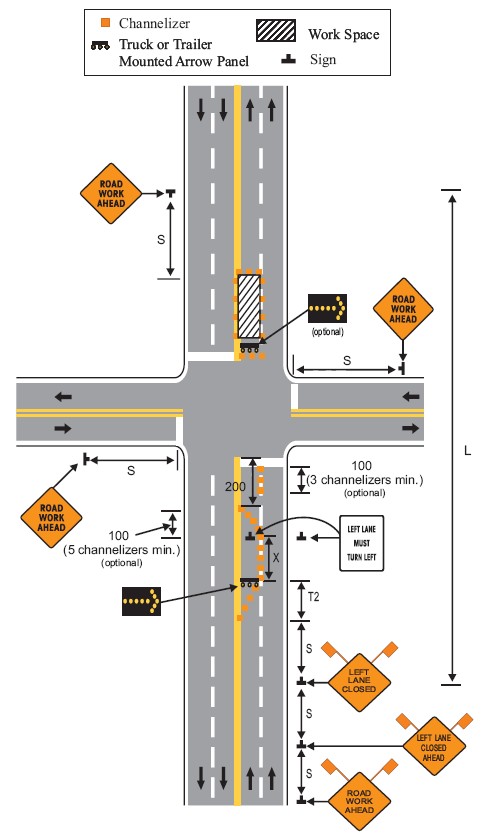
This typical application is applicable to intersections with right of way control on all approaches.
A protective vehicle shall be used while work is in progress when space allows. The protective vehicle should be equipped with a TMA and positioned at least 150 ft. in advance of the workspace. The protective vehicle may be eliminated if the roadway is posted at 45 mph or below, the work vehicle is positioned in advance of the workspace, and the work vehicle uses activated rotating lights or strobe lights.
At locations where left turn movements are minimal or where the inclusion of the turning traffic with the traffic using the adjacent open lane will not affect capacity of the approach, it is acceptable to close any lane not carried through the intersection prior to the intersection. Thereby, eliminating the turn bay shown. If left-turn movements are significant, however, the left lane may be left open prior to the intersection but restricted to left-turn movements only. In this case, all channelization devices prior to the intersection are eliminated except those that might be used to form a temporary island emphasizing the mandatory turning movement.
If the workspace extends across the sidewalk, the crosswalk should be closed using the information and devices shown in 616.23.3.25 TA-25 Crosswalk Closures and Pedestrian Detours.
Buffer and taper lengths noted in table may be modified to fit conditions.
For short duration operations, signs and channelizers may be reduced or eliminated.
For mobile operations where workers are on foot and move with the operation, channelizers may be reduced or eliminated.
Where possible, signs should be provided on both sides of the affected approach when the approach is two or more lanes wide.
For high speed facilities, channelizer spacing may be reduced to ½ spacing noted in Table 616.23.3.21.1, above.
Other appropriate signs may be used in lieu of the ROAD WORK AHEAD sign.
Supplemental warning methods may be used to call attention to the work zone.
| pdf. version of TA-22 |
616.23.3.22 TA-22 Lane Closure of Right Lane on Far Side of Intersection
Table 616.23.3.22.1
| Speed | Sign Spacing (ft.) | Taper Length (ft.) | Optional Buffer Length, B (ft.) | Longitudinal Transition, X | Channelizer Spacing (ft.) | |||
|---|---|---|---|---|---|---|---|---|
| Undivided, S | Divided, S | Shoulder, T1 1 | Lane, T2 2 | Tapers | Buffer/Work Areas | |||
| 0 - 35 | 200 | 200 | - | 245 | 120 | 120 | 15 | 25 |
| 40 - 45 | 350 | 500 | - | 540 | 220 | 270 | 20 | 50 |
| 50 - 55 | 500 | 1000 | - | 660 | 335 | 330 | 50 | 100 |
| 60 - 70 | 1000 | 1000 | - | 840 | 550 | 420 | 60 | 100 |
| 1 Shoulder taper length based on 10 ft. (standard shoulder width) offset | ||||||||
| 2 Lane taper length based on 12 ft. (standard lane width) offset | ||||||||
| Table 616.23.3.22.2 | ||
| Roadway Type | Sign Height | Max. Work Zone Length, L |
|---|---|---|
| Urban | 1 ft., Portable | 1 mile |
| 7 ft., Post | ||
| Rural Divided | 1 ft., Portable | 2 miles |
| 7 ft., Post | ||
| Rural Undivided | 1 ft., Portable | 3 miles |
| 5 ft., Post | ||
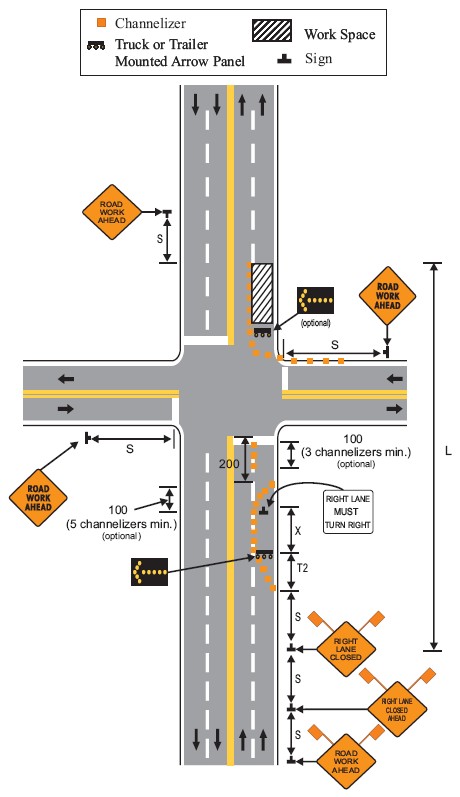
This typical application is applicable to intersections with right of way control on all approaches.
A protective vehicle shall be used while work is in progress when space allows. The protective vehicle should be equipped with a TMA and positioned at least 150 ft. in advance of the workspace. The protective vehicle may be eliminated if the roadway is posted at 45 mph or below, the work vehicle is positioned in advance of the workspace, and the work vehicle uses activated rotating lights or strobe lights.
At locations where right turn movements are minimal or where the inclusion of the turning traffic with the traffic using the adjacent open lane will not affect capacity of the approach, it is acceptable to close any lane not carried through the intersection prior to the intersection. Thereby, eliminating the turn bay shown. If right-turn movements are significant, however, the right lane may be left open prior to the intersection but restricted to right-turn movements only. In this case, all channelization devices prior to the intersection are eliminated except those that might be used to form a temporary island emphasizing the mandatory turning movement.
For intersection approaches reduced to a single lane, left-turning movements may be prohibited to maintain capacity for through motor vehicle traffic.
If the workspace extends across the crosswalk, the crosswalk should be closed using the information and devices shown in 616.23.3.25 TA-25 Crosswalk Closures and Pedestrian Detours.
Buffer and taper lengths noted in table may be modified to fit conditions.
For short duration operations, signs and channelizers may be reduced or eliminated.
For mobile operations where workers are on foot and move with the operation, channelizers may be reduced or eliminated.
Where possible, signs should be provided on both sides of the affected approach when the approach is two or more lanes wide.
For high speed facilities, channelizer spacing may be reduced to ½ spacing noted in Table 616.23.3.22.1.
Other appropriate signs may be used in lieu of the ROAD WORK AHEAD sign.
Supplemental warning methods may be used to call attention to the work zone.
| pdf. version of TA-23 |
616.23.3.23 TA-23 Lane Closure of Near Side on Intersection
Table 616.23.3.23.1
| Speed | Sign Spacing (ft.) | Taper Length (ft.) | Optional Buffer Length, B (ft.) | Channelizer Spacing (ft.) | |||
|---|---|---|---|---|---|---|---|
| Undivided, S | Divided, S | Shoulder, T1 1 | Lane, T2 2 | Tapers | Buffer/Work Areas | ||
| 0 - 35 | 200 | 200 | - | 245 | 120 | 15 | 25 |
| 40 - 45 | 350 | 500 | - | 540 | 220 | 20 | 50 |
| 50 - 55 | 500 | 1000 | - | 660 | 335 | 50 | 100 |
| 60 - 70 | 1000 | 1000 | - | 840 | 550 | 60 | 100 |
| 1 Shoulder taper length based on 10 ft. (standard shoulder width) offset | |||||||
| 2 Lane taper length based on 12 ft. (standard lane width) offset | |||||||
| Table 616.23.3.23.2 | ||
| Roadway Type | Sign Height | Max. Work Zone Length, L |
|---|---|---|
| Urban | 1 ft., Portable | 1 mile |
| 7 ft., Post | ||
| Rural Divided | 1 ft., Portable | 2 miles |
| 7 ft., Post | ||
| Rural Undivided | 1 ft., Portable | 3 miles |
| 5 ft., Post | ||
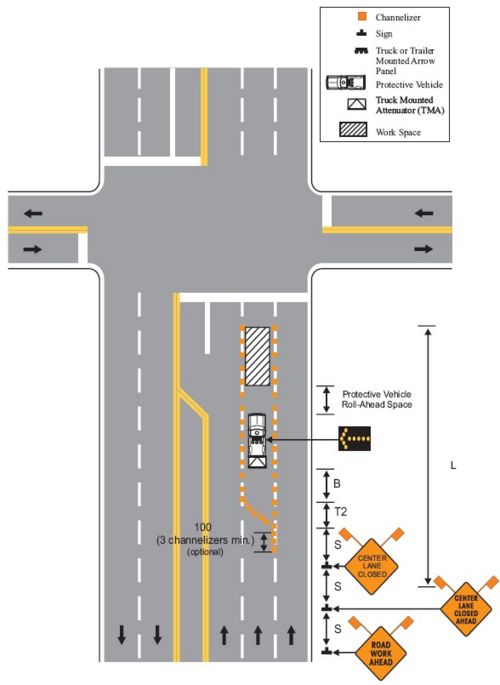
This typical application is applicable to intersections with right of way control on all approaches.
A protective vehicle shall be used while work is in progress. The protective vehicle should be equipped with a TMA and flashing arrow panel and positioned at least 150 ft. in advance of the workspace, if possible. The protective vehicle may be eliminated if the roadway is posted at 45 mph or below, the work vehicle is positioned in advance of the workspace, and the work vehicle with a flashing arrow panel and uses activated rotating lights or strobe lights.
The taper shall direct traffic into either the right or left lane, but not both. The display on the flashing arrow panel shall match the direction of the taper.
In this typical application, a left taper is used so right-turn movements will not impede through traffic. The reverse setup should be used if the volume of left-turn movements is a major concern.
If the workspace extends across the crosswalk, the crosswalk should be closed using the information and devices shown in 616.23.3.25 TA-25 Crosswalk Closures and Pedestrian Detours.
For short duration operations, signs and channelizers may be reduced or eliminated.
For mobile operations where workers are on foot and move with the operation, channelizers may be reduced or eliminated.
Where possible, signs should be posted on both sides of the affected approach.
For high speed facilities, channelizer spacing may be reduced to ½ spacing noted in Table 616.23.3.23.1.
Supplemental warning methods may be used to call attention to the work zone.
| pdf. version of TA-24 |
616.23.3.24 TA-24 Sidewalk Detour or Diversion
Table 616.23.3.24
| Speed | Sign Spacing (ft.) | Taper Length (ft.) | Optional Buffer Length, B (ft.) | Channelizer Spacing (ft.) | |||
|---|---|---|---|---|---|---|---|
| Undivided, S | Divided, S | Shoulder, T1 1 | Lane, T2 2 | Tapers | Buffer/Work Areas | ||
| 0 - 35 | 200 | 200 | 70 | - | 120 | 15 | 25 |
| 40 - 45 | 350 | 500 | 150 | - | 220 | 20 | 50 |
| 50 - 55 | 500 | 1000 | 185 | - | 335 | 50 | 100 |
| 60 - 70 | 1000 | 1000 | 235 | - | 550 | 60 | 100 |
| 1 Shoulder taper length based on 10 ft. (standard shoulder width) offset | |||||||
| 2 Lane taper length based on 12 ft. (standard lane width) offset | |||||||
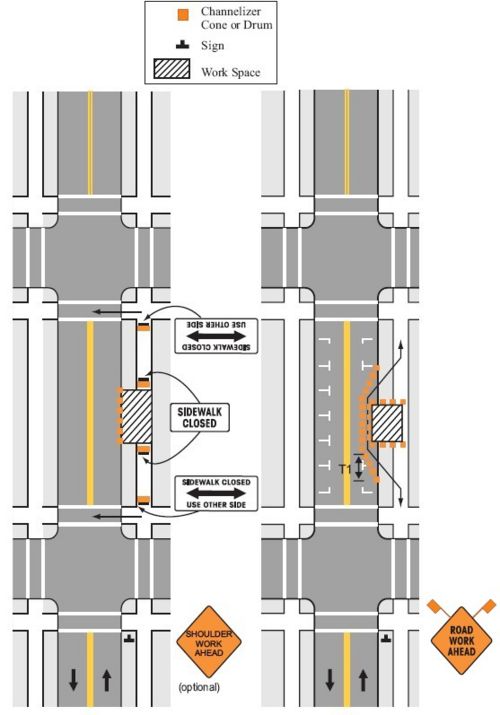
Where sidewalks exist, provisions should be made for disabled persons.
Where high speeds are anticipated, a temporary traffic barrier and, if necessary, a crash cushion should be used to separate the temporary sidewalks from traffic.
Only the temporary traffic control devices related to pedestrians are shown. Other devices may be necessary to control traffic.
Signs may be mounted on portable mounts at 1 ft. provided they do not interfere with pedestrian movement or be obstructed by parking. Otherwise, signs shall be mounted at 7 ft.
For high speed facilities, channelizer spacing may be reduced to ½ spacing noted in Table 616.23.3.24.
Other appropriate signs may be used in lieu of the SHOULDER WORK AHEAD or ROAD WORK AHEAD signs.
| pdf. version of TA-25 |
616.23.3.25 TA-25 Crosswalk Closures and Pedestrian Detours
Table 616.23.3.25
| Speed | Sign Spacing (ft.) | Taper Length (ft.) | Optional Buffer Length, B (ft.) | Channelizer Spacing (ft.) | |||
|---|---|---|---|---|---|---|---|
| Undivided, S | Divided, S | Shoulder, T1 1 | Lane, T2 2 | Tapers | Buffer/Work Areas | ||
| 0 - 35 | 200 | 200 | - | - | 120 | 15 | 25 |
| 40 - 45 | 350 | 500 | - | - | 220 | 20 | 50 |
| 50 - 55 | 500 | 1000 | - | - | 335 | 50 | 100 |
| 60 - 70 | 1000 | 1000 | - | - | 550 | 60 | 100 |
| 1 Shoulder taper length based on 10 ft. (standard shoulder width) offset | |||||||
| 2 Lane taper length based on 12 ft. (standard lane width) offset | |||||||
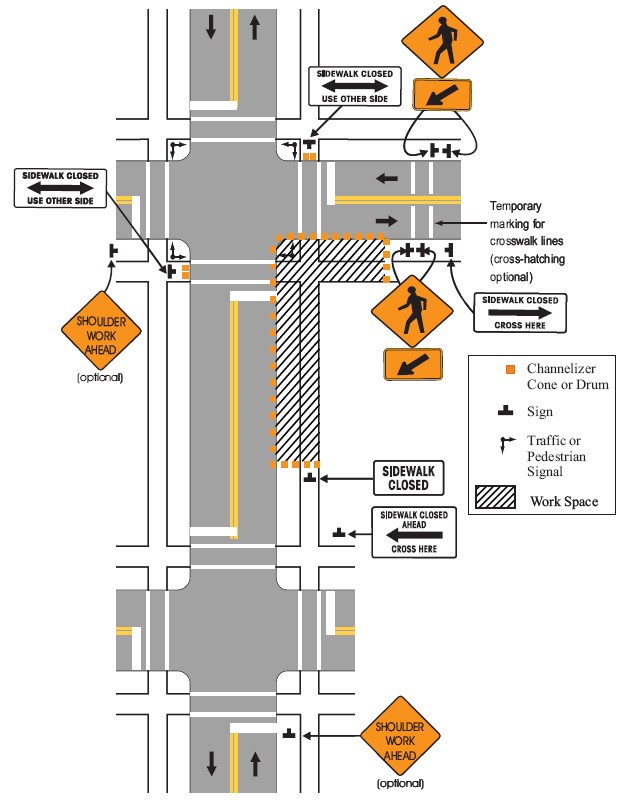
Where sidewalks exist, provisions should be made for disabled persons.
Curb parking shall be prohibited for at least 50 ft. in advance of the mid-block crosswalk.
Pedestrian traffic signal displays controlling closed crosswalks should be covered or deactivated.
Only the temporary traffic control devices related to pedestrians are shown. Other devices may be necessary to control traffic.
Signs may be mounted on portable mounts at 1 ft. provided they do not interfere with pedestrian movement or be obstructed by parking. Otherwise, signs shall be mounted at 7 ft.
For high speed facilities, channelizer spacing may be reduced to ½ spacing noted in Table 616.23.3.25.
Other appropriate signs may be used in lieu of the SHOULDER WORK AHEAD sign.
| pdf. version of TA-26 |
616.23.3.26 TA-26 Highway Closure
Table 616.23.3.26.1
| Speed | Sign Spacing (ft.) | Taper Length (ft.) | Optional Buffer Length, B (ft.) | Channelizer Spacing (ft.) | |||
|---|---|---|---|---|---|---|---|
| Undivided, S | Divided, S | Shoulder, T1 1 | Lane, T2 2 | Tapers | Buffer/Work Areas | ||
| 0 - 35 | 200 | 200 | - | - | 120 | - | - |
| 40 - 45 | 350 | 500 | - | - | 220 | - | - |
| 50 - 55 | 500 | 1000 | - | - | 335 | - | - |
| 60 - 70 | 1000 | 1000 | - | - | 550 | - | - |
| 1 Shoulder taper length based on 10 ft. (standard shoulder width) offset | |||||||
| 2 Lane taper length based on 12 ft. (standard lane width) offset | |||||||
| Table 616.23.3.26.2 | ||
| Roadway Type | Sign Height | Max. Work Zone Length, L |
|---|---|---|
| Urban | 1 ft., Portable | 1 mile |
| 7 ft., Post | ||
| Rural Divided | 1 ft., Portable | 2 miles |
| 7 ft., Post | ||
| Rural Undivided | 1 ft., Portable | 3 miles |
| 5 ft., Post | ||
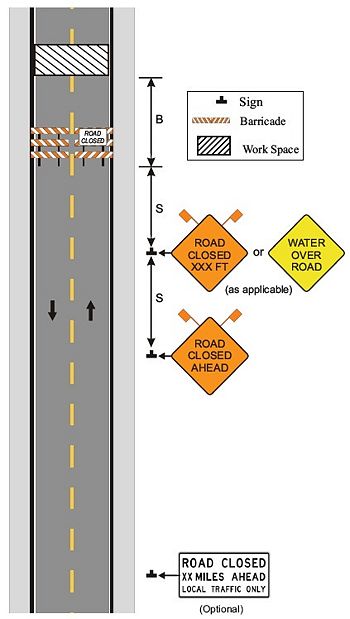
Additional barricades may be located in advance of the barricades shown to provide earlier notification of the closure. These barricades may be offset to facilitate access for work vehicles, local traffic, etc.
Traffic control should be removed as soon as practical after condition for the closure no longer exists.
If used, the ROAD CLOSED XX MILES AHEAD LOCAL TRAFFIC ONLY sign should be located at the first state highway intersection or, upon the discretion of the supervisor, any other intersection in advance of the closure.
Flags shall be used on temporary signs, not permanent hinged signs.
For water over road situations, permanent hinged signs may be considered at locations that experience recurring flooding. Possible sign combinations are:
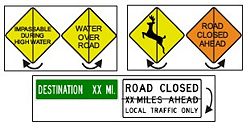 |
For planned activities, Community Relations should be notified.
For long-term closure, detour signing should be considered.
Additional warning signs should be erected at each intersection within the work zone.
Supplemental warning methods may be used to call attention to the work zone.
| pdf. version of TA-27 |
616.23.3.27 TA-27 Lane Closure Using Two-Way Left Turn Lane on Undivided Highways
Table 616.23.3.27.1
| Speed | Sign Spacing (ft.) | Taper Length (ft.) | Optional Buffer Length, B (ft.) | Channelizer Spacing (ft.) | |||
|---|---|---|---|---|---|---|---|
| Undivided, S | Divided, S | Shoulder, T1 1 | Lane, T2 2 | Tapers | Buffer/Work Areas | ||
| 0 - 35 | 200 | - | 70 | 245 | 120 | 35 | 50 |
| 40 - 45 | 350 | - | 150 | 540 | 220 | 40 | 100 |
| 50 - 55 | 500 | - | 185 | 660 | 335 | 50 | 100 |
| 60 - 70 | 1000 | - | 235 | 840 | 550 | 60 | 100 |
| 1 Shoulder taper length based on 10 ft. (standard shoulder width) offset | |||||||
| 2 Lane taper length based on 12 ft. (standard lane width) offset | |||||||
| Table 616.23.3.27.2 | ||
| Roadway Type | Sign Height | Max. Work Zone Length, L |
|---|---|---|
| Urban | 1 ft., Portable | 1 mile |
| 7 ft., Post | ||
| Rural Undivided | 1 ft., Portable | 3 miles |
| 5 ft., Post | ||
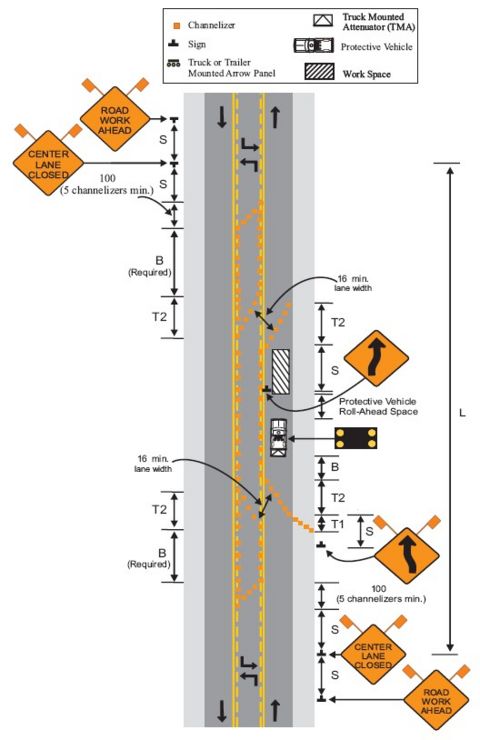
A protective vehicle shall be used while work is in progress. The protective vehicle should be equipped with a TMA and flashing arrow panel and positioned at least 150 ft. in advance of the workspace. The protective vehicle may be eliminated if the roadway is posted at 45 mph or below, the work vehicle is positioned in advance of the workspace, and the work vehicle uses activated rotating lights or strobe lights.
Channelizer spacing may be reduced to discourage turning traffic from entering the two-way left turn lane.
For short duration operations, signs and channelizers may be reduced or eliminated.
For mobile operations where workers are on foot and move with the operation, channelizers may be reduced or eliminated.
Additional warning signs shall be erected at each intersection with another state highway within the work zone. Upon the discretion of the supervisor, additional warning signs may be erected at other intersections within the work zone.
| pdf. version of TA-28 |
616.23.3.28 TA-28 Lane Closure on Alternate Passing Lanes
Table 616.23.3.28.1
| Speed | Sign Spacing (ft.) | Taper Length (ft.) | Optional Buffer Length, B (ft.) | Channelizer Spacing (ft.) | |||
|---|---|---|---|---|---|---|---|
| Undivided, S | Divided, S | Shoulder, T1 1 | Lane, T2 2 | Tapers | Buffer/Work Areas | ||
| 0 - 35 | 200 | - | 70 | 245 | 120 | 35 | 50 |
| 40 - 45 | 350 | - | 150 | 540 | 220 | 40 | 100 |
| 50 - 55 | 500 | - | 185 | 660 | 335 | 50 | 100 |
| 60 - 70 | 1000 | - | 235 | 840 | 550 | 60 | 100 |
| 1 Shoulder taper length based on 10 ft. (standard shoulder width) offset | |||||||
| 2 Lane taper length based on 12 ft. (standard lane width) offset | |||||||
| Table 616.23.3.28.2 | ||
| Roadway Type | Sign Height | Max. Work Zone Length, L |
|---|---|---|
| Urban | 1 ft., Portable | 1 mile |
| 7 ft., Post | ||
| Rural Undivided | 1 ft., Portable | 3 miles |
| 5 ft., Post | ||
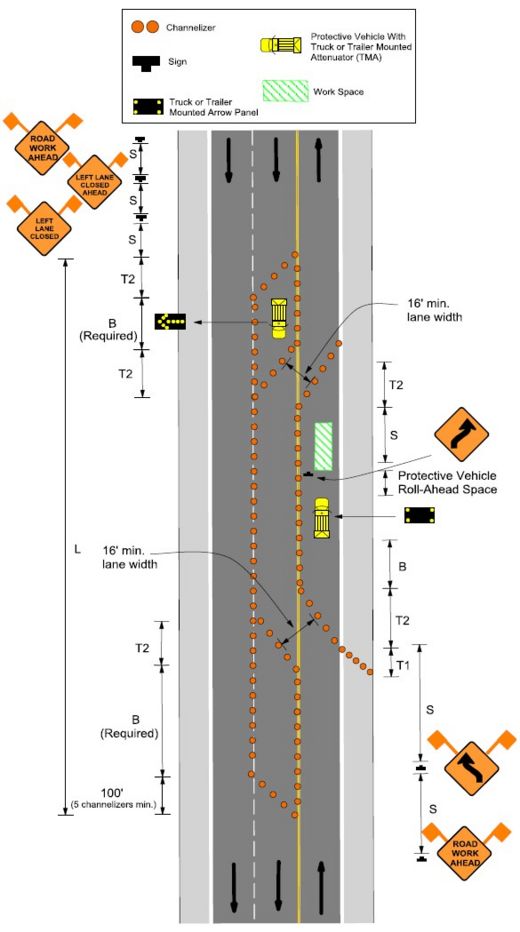
A protective vehicle shall be used while work is in progress. The protective vehicle shall be equipped with a TMA and flashing arrow panel and positioned at least 150 ft. in advance of the workspace. The protective vehicle may be eliminated if the roadway is posted at 45 mph or below, the work vehicle is positioned in advance of the workspace, and the work vehicle uses activated rotating lights or strobe lights.
For short duration operations, signs and channelizers may be reduced or eliminated.
For mobile operations where workers are on foot and move with the operation, channelizers may be reduced or eliminated.
For one-lane mobile operations, refer to 616.23.3.4 TA-4 Mobile Operations on Two-Lane Highways.
For two-lane mobile operations, refer to 616.23.3.5 TA-5 Mobile Operations on Divided or Multi-Lane Highways.
Additional warning signs shall be erected at each intersection with another state highway within the work zone. Upon the discretion of the supervisor, additional warning signs may be erected at other intersections within the work zone.